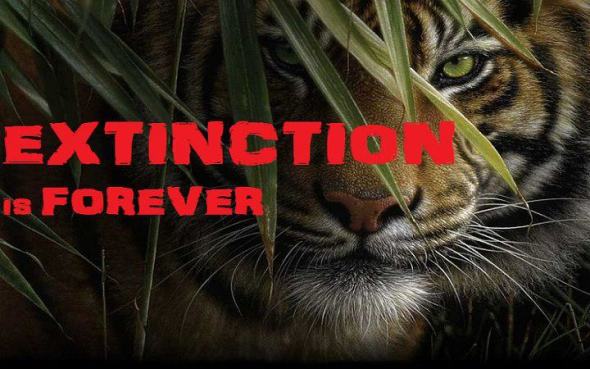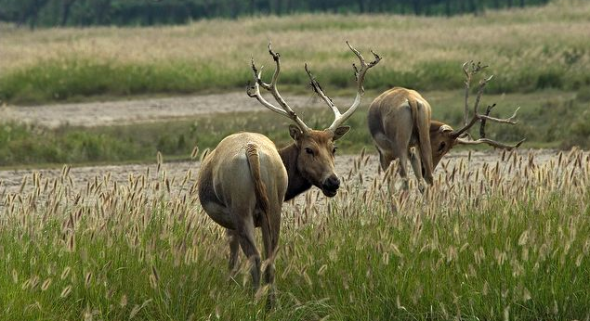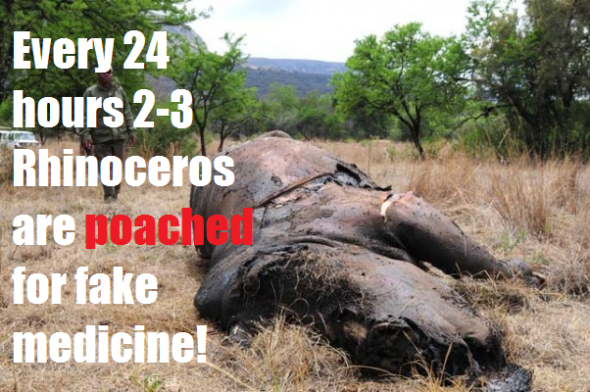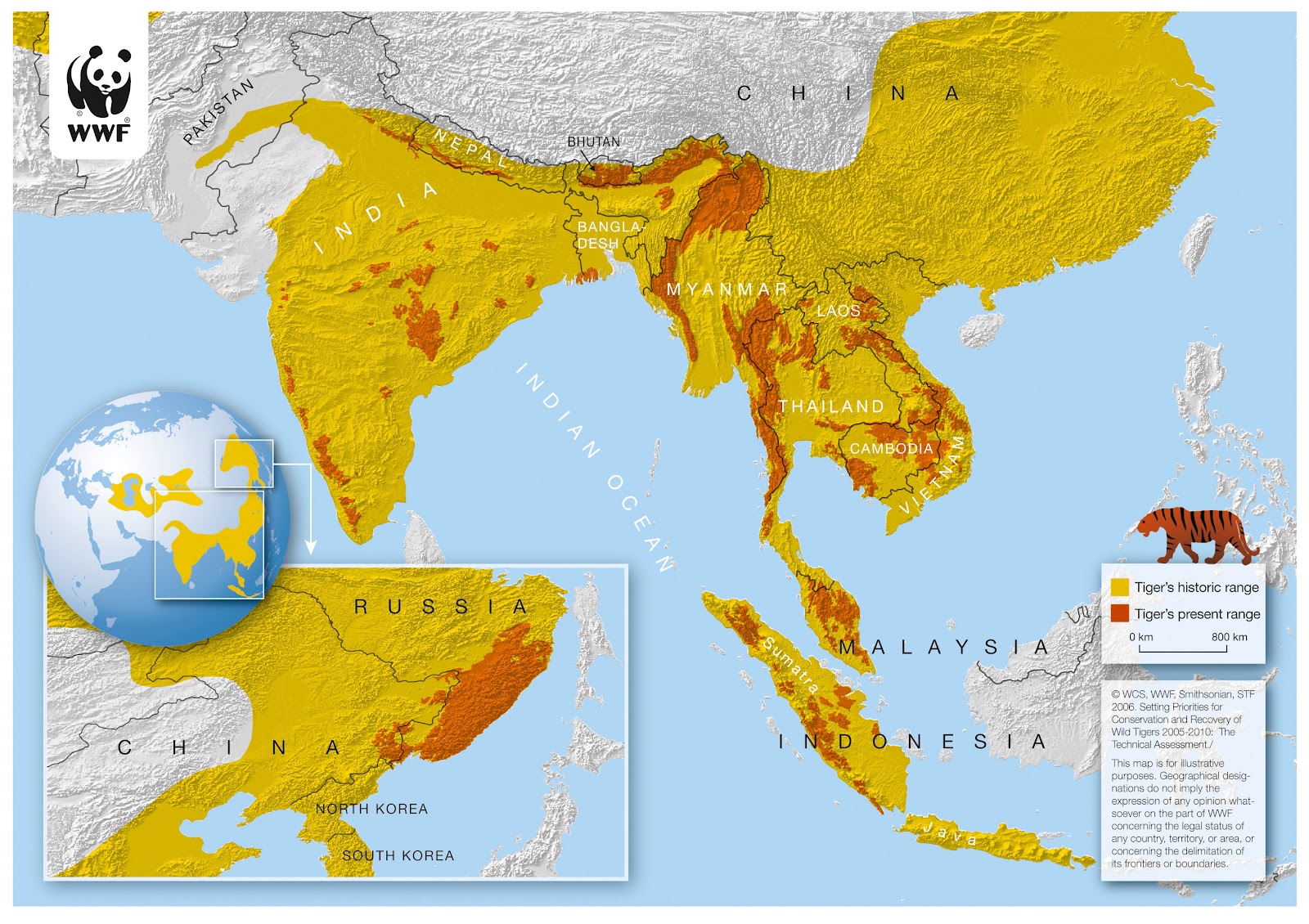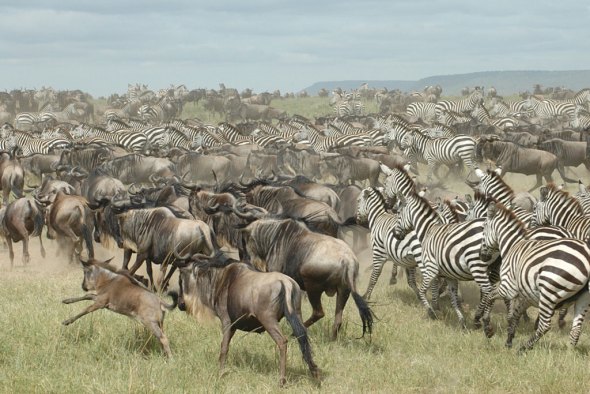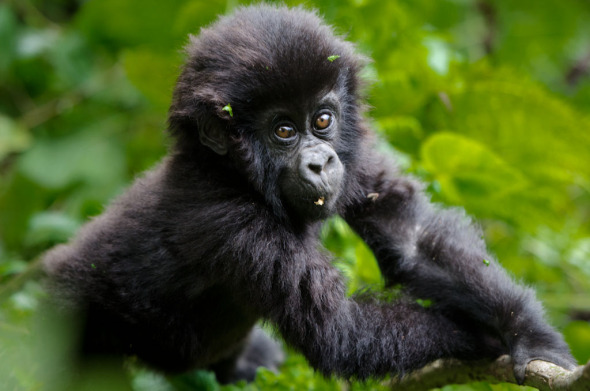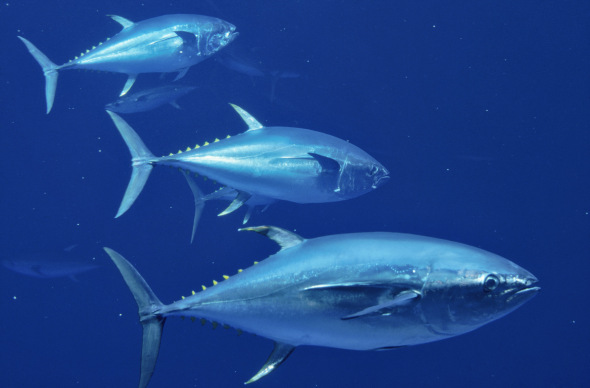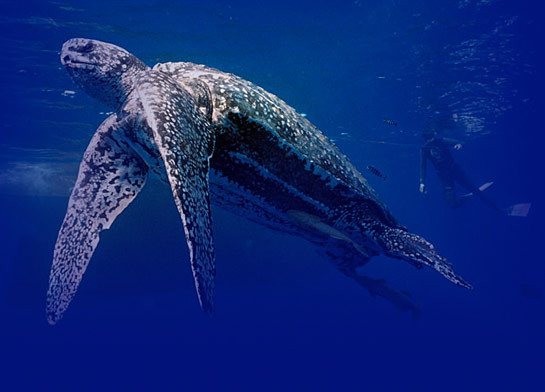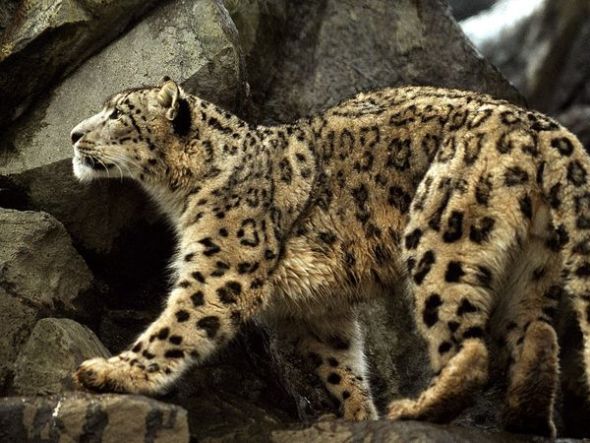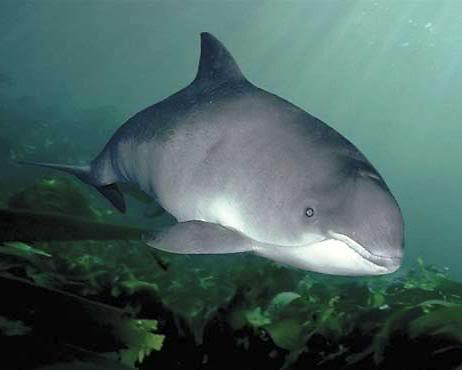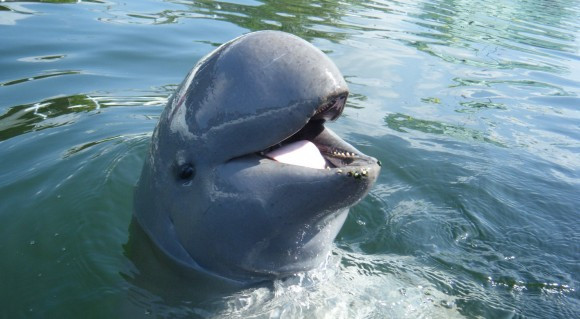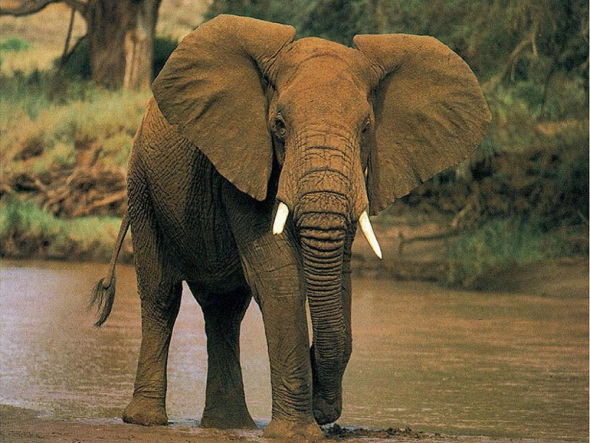Can hunting lead to Species Extinction?
Its a topic that we see spoken about within many animal rights and conservation debate forums, can hunting lead to species extinction? The answer is yes hunting can if not monitored lead directly to species extinction.
The many arguments that quote Cites can help stop species from extinction is not really valid. Cites - Convention on International Trade of Endangered Species does not cover the entire globe.
To date there are a total of one hundred and sixty member states (2013) that are bound by the Cites agreement. So in not so many words hunting can be (restricted) however this doesn’t mean that the member states have to agree with what Cites and other member states call for. Cites was established back in the early 1970’s of which has seen many species of animals and plants preserved. One must remember though that hunting is not the real threat to animals, humans are via over populating that leads to mass habitat fragmentation in many ways. Increased farming, urbanization and depletion of natural resources such as wood have had quite a profound affect to many species of plant and animal.
Case Study #1
Identified in 1826 by Cretzschmar - Oryx dammah.
(Extinct within the wild)..
O. dammah
The Oryx dammah is only extinct within the wild. However, 14,636 km away the Oryx dammah is not extinct on US ranches?, 14,636 km on a private farm in Texas these adorable mammals are trophy hunted. One would think that the farm would actually create a captive breeding program to reintroduce species of O. dammah back in the wild of Northern Africa.
Back in the 1960’s a global captive breeding program was launched when it was finally documented that hunters had literally over hunted the species into extinction. At the same time the African black and white Rhino was bordering extinction however won a reprieve, sadly even they are no longer safe bordering tipping point.
In 2005 a captive breeding assessment showed around some 1,500 individuals of O. dammah within captivity. From 2000-2007 the species was formally identified as completely extinct within the wild. In Chad and Niger it was estimated that a mere five hundred individuals were known to still be living within the wild from 1985. Scimitar horned oryx (common name) is regionally extinct within Algeria, Burkina Faso, Chad, Egypt, Libya, Mali, Mauritania, Morocco, Niger, Nigeria, Senegal, Sudan, Tunisia and the Western Sahara.
Hunters can agree or disagree. The evidence is clear today as it was back in the mid-1980’s when the species was formally assessed as (critically endangered).. Hunters are responsible for pushing species of mammal whether it be the Lion or the O. dammah into extinction. What really concerns International Animal Rescue Foundation’s conservation team is that environmental departments and enforcement agencies were fully aware many species of animals are threatened from human selfishness. Cites was not aware as the treaty was only drawn into practice back in the early 1970’s. Had the Convention on International Trade of Endangered Species that hosts some 160 member states been made aware of the plight of the O. dammah its quite possible they’d still be living within the wild.
Environmental departments on the African continent knew the O. dammah populations were being seriously depleted. So did international agencies. The O. dammah could have been taken into a secure captive breeding program way sooner than the 1960’s and/or protective secure parks established and manned to secure the species within the wild.
Over-hunting and habitat loss, including competition with domestic livestock, have been reported as the main reasons for the extinction of the wild population of Scimitar-horned oryx. Hunters still to this very day propagate unproven data stating the O. dammah is still pretty much alive within the wild. You’ll find that most of these hunters are either cattle ranchers that have never visited our Mama Africa or keyboard hunters that take facts from various sources outdated or unproven.
International Animal Rescue Foundation - Africa located seven ranches inside of the United States that allows tropical hunting of the O. dammah. One ranch we contacted we asked if they would be willing to ship out to Africa a dozen O. dammah for breeding yet we was informed the cattle were only hunted for trophies. Even with money talking not one ranch was willing to comply. (Please note we do not own a captive breeding facility)…
Cattle Ranches in Texas sell for hunting O. dammah Yearling Heifer/Bull priced at $800.00USD, cows as $1,100.00USD and bulls up to 36 inches at $1,300.00USD.. All included - to hunt sets you back a staggering $3,250.00.
Regardless of what hunters state there has been no definite evidence of the survival of this species in the wild for more than 15 years. Yet speak to a few Texan hunters and they’ll inform you otherwise. Sporadic reports of animals sighted in Niger and Chad have never been substantiated, despite extensive surveys dedicated to detection of Sahelo-Saharan antelopes carried out in Chad and Niger in 2001-2004.
It is sadly a fact that hunting whether it be trophy hunting or hunting for bush-meat has contributed to the extinction of this species within the wild. Any hunter that states no species of animal has ever been pushed to extinction within the past twenty years other than the Dodo and Tasmanian Tiger are bare faced uneducated liars that lack any form of conservationism education as their only type of conservation is keeping numbers down commonly known as “hunting” - Its hardly conserving any form of animal.
Case Study #2
Identified in 1866 by Milne and Edwards - Elaphurus davidianus
(Extinct within the wild)
E. davidianus
This species is listed as Extinct in the Wild, as all populations are still under captive management. The captive population in China has increased in recent years, and the possibility remains that free-ranging populations can be established some time in the near future. When that happens, its Red List status will need to be reassessed.
So here is that hunters (propaganda again) within many debates that we read within Animal Rights and conservation forums. The average hunter still argues that no animal has been pushed to extinction via hunting within the past two decades or less. Back in 1990 the Pere David’s Deer as it is commonly known was listed as (endangered). Cites that was well established back then knew this species of deer was facing extinction so did all member states as well as enforcement agencies and Department of Environments yet done nothing to preserve its status until now.
From 1994 the Pere David’s Deer was re-listed as endangered. From 1996 the species was listed again as (critically endangered). Sometime from 1980-1990 the species was re-listed as completely extinct within the wild of which prompted conservation agencies (only when we’d lost the species in the wild) to then begin a captive breeding program. Thankfully and after much success captive bred numbers have increased to over two thousand individuals. What was the main cause for their extinction within the wild?
The species became extinct in the wild due to habitat loss and hunting. The size of the reintroduced population was only 120 in 1993, although has increased to over 2,000 since that time. Low genetic diversity has been identified as a long-term threat by Zeng et al. (2007) and Yang et al. (2008). It is unclear how much native habitat remains on which E. davidianus can exist in a free-ranging state. Is it possible that the species can be reinstated to live freely within the wild? We believe so however to what extent they can remain (wild) within the (wild) is another story.
Would a reintroduction program of the Pere’s David Deer work though? I the Chief Environmental Officer Dr Josa Depre question this time again regarding many species of “horned” mammal that are currently threatened. So, we take a look at why the species E. davidianus was threatened? Firstly blaming US or any overseas hunters is not primarily to blame here. One only has to look at why the species was pushed into extinction to ascertain whether it is actually practical or even professional to reintroduce the species back into the wild of China from which it is endemic too.
Firstly I do not believe in the current climate of poaching and black market wildlife trade that reintroduction of the Pere’s David Deer is practical. E. davidianus was hunted mainly by Asian hunters legally and illegally. Hunted to extinction within the wild mainly for its fur, skeletons, meat, glands and derivatives. if one researches you’ll locate evidence of the Pere’s David Deer used in (TCM) commonly known as Traditional Chinese Medicine. This particular deer was hunted mostly for its glands and skeleton. Musk is wildly used within the far east as a Traditional Medicine and for the use of perfumes (internationally) that sell for hundreds of dollars. However and as shocking as this may read the Pere’s David Deer was hunted for its skeleton for the production of bone wines that is said to enhance sexual pleasure in both men and women.
However we cannot just lay blame here all on the Traditional Chinese Medicine trade. Hunters from all over the globe hunted the Pere’s David Deer mainly for its large and well formed antlers. Furthermore locals and Asians outside of China also hunted the deer for its meat known to be aromatic and tender.
Populations of the Pere’s David Deer are now increasing within (captivity).. Currently, there are a total of 53 herds of E. davidianus in China. Nine herds have fewer than 25 deer, 75.5% have fewer than 10 deer (Yang et al., 2003). Such a small herd size raise question about the effective population size and health of population genetics, since those herds are isolated and there is no gene exchange. The artificially dispersed E. davidianus herds are similar to a meta-population. The viability of the meta-population depends on the man-made gene exchange process by the managers.
Concerns via the International Union for the Conservation of Nature 2009:
A quarter of all antelope species are threatened with extinction.
The results, compiled by the Antelope Specialist Group of IUCN’s Species Survival Commission, show that out of 91 species of antelope, 25 are threatened with extinction. The status of several species has become worse since the last complete assessment of all antelopes in 1996.
“Unsustainable harvesting, whether for food or traditional medicine, and human encroachment on their habitat are the main threats facing antelopes,” says Dr Philippe Chardonnet, Co-Chair of the IUCN Antelope Specialist Group. “Most antelopes are found in developing countries which is why it’s critically important that we collaborate with local communities there since it is in their own interest to help preserve these animals.”
Five species of antelope are in the highest category of threat, Critically Endangered, including the Dama Gazelle (Nanger dama), Aders’ Duiker (Cephalophus adersi), the Saiga Antelope (Saiga tatarica), Hirola (Beatragus hunteri) and Addax (Addax nasomaculatus). The Scimitar Horned Oryx (Oryx dammah) is already Extinct in the Wild, but there are ongoing efforts to reintroduce it. The Dama Gazelle and Addax are both reduced to tiny remnant populations and highlight the dire situation for wildlife in the Sahelo-Saharan region.
A further nine species are in the next category of threat, Endangered, and another nine are classified as Vulnerable on the IUCN Red List of Threatened Species.
Nearly 70 percent of antelope species are not threatened with extinction and some areas of the world are doing better than others in terms of antelope populations. India, for example, is home to four species of antelope and only one of them is currently regarded as threatened.
“Despite the pressure of living alongside 1.2 billion people, antelopes are doing well in India,” says Dr David Mallon, Co-Chair of the IUCN Antelope Specialist Group. “It is no coincidence that there is very little tradition of hunting in India and gun ownership is rare.”
Overall, populations are stable in 31 percent of antelope species and decreasing in 62 percent of antelope species. The Springbok (Antidorcas marsupialis) a native of southern Africa is the only antelope species with a long-term increasing trend, mainly as a result of the game ranching industry.
Conclusion;
Today I have written this article for the many hundreds of Animal Rights Activists and Conservationists in training that are constantly put down by hunters for being “thick” knowing little about what they are actually debating about. Frankly I could go on and submit here another twelve species of mammal and several species of plants that have gone extinct within the wild caused primarily by human hunters and traffickers. Whether it be hunting for food, hunting illegally for the animal parts trade or trophy hunting the answer to the title Can hunting lead to species extinction even with Cites established is quite rightfully yes. My main beef here is that Cites and Governmental Environmental Agencies are fully aware of the many species of land and aquatic mammal that are facing extinction or seriously threatened within the wild. Yet have done little or nothing at all to conserve threatened species. Hunting does and has lead to many species of plant and animals going extinct. The Lion, Rhinoceros, Pangolin, Cheetah, many species of bird and Sharks even trees are all facing extinction within the wild and its hunters, poachers and traffickers that are all to blame. Whether hunting is legal or not without adequate and professional monitoring “any species of mammal or plant” can quite quickly vanish from under our noses.
While the two species above and some sixty nine species are formally extinct within the wild they are at the moment the very lucky ones. Conservation programs are at their very best helping to conserve the known sixty nine species of animal and plant. However there are a total of eight hundred and twenty eight recognized species of animal, fish and plants that are already extinct.
Extinction Means Forever..
If you would like you a fact a sheet on this article or wish to know more please contact myself or my Senior Environmental Officer at - info@international-animalrescue-foundation.org.uk.
Dr Josa C. Depre
Environmentalist and Botanical Scientist
Rhino War and Photography
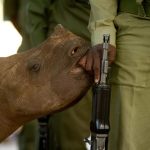

Rhino poaching within Africa has reached yet again an all time new high with a total of some 543 Rhinoceros poached dead for Traditional Chinese Medicine. Even with vast awareness campaigns, increased border patrols, upping Anti Poaching and funding the killing continues. Will it ever end? how long is a piece of string?
From the 30th June 2014 the (DEA) Department Of Environmental Affairs (South Africa) issued their Rhino poaching statistics of which was then 496. Since then a further 50+ have been bludgeoned leaving many people feeling hopeless, let down by their government, and debating on whether it is really a practical choice to support a trade in Rhino horn.
Poaching statistics for 2014 have again beaten records for the years 2010-2011. For both years, poaching statistics for 2010 were 333 poached Rhino and for the year 2011 we saw a total kill rate of 448. Poaching statistics for 2012 look as if they are most likely going to be beaten by this years June-July figures too that saw a total of 668 Rhinoceros poached in cold blood.
On a positive note arrest rates are also allegedly increasing from last year that saw a sky-rocketing 1003 Rhinoceros poached. Increased arrest rates doesn’t necessarily mean we are winning the battle, it merely shows that more and more poachers are encroaching from over the border into South Africa. 2010 saw a total of 165 poachers arrested, 2011 - 232, then in 2012 a total of 267 poachers were arrested, 2013 arrest rates shot up of which a total of 343 Rhino poachers were arrested. For June-July 2014 a total (estimate) arrest rate sees some 141 arrested. So 1148 poachers have been arrested yet we have only seen a handful of these poachers actually charged, brought to justice and convicted.
Its hard to actually believe too that Rhino horn made up of almost the same identical properties as human hair, finger nails, horse hoof, and parrot beak is selling illegally on the black market for a whopping $65,000kg whereas gold sells for a mere $43,000 kg and cocaine illegally trading at some $20,000 kg. Demand is not decreasing and while demand increases so will poaching and as explained there seems to be no end of the onslaught insight.
A powder made from the horns is prescribed in traditional Chinese medicine to cure fever and convulsions, but the substance is now used as a status symbol and a very expensive way for affluent Vietnamese to cure hangovers or, supposedly, to get high—even though the horns are composed of the common material keratin and have about the same psychoactive effects as snorting a fingernail clipping.
By weight, the horns go for anywhere from $60,000 to $100,000 per kilogram—single horns are about 3.5 kg, on average—making the substance significantly more pricey than other ubiquitous status symbols and intoxicants. Indian Rhino horns are still the most sought after and pricer too. International Animal Rescue Foundation Africa spoke with their Indian counterparts of which confirmed Indian Rhino horn is illegally trading for $80,000 kg. The reason for such high price is mainly due to the Indian Rhino’s endangered status. South Africa is home to about 75% of the world’s 29,000 rhinoceroses, but if the country can’t stop the poaching, it may lose that status, said Naomi Doak of the wildlife monitoring network, Traffic. “We are going to reach the tipping point for rhinos,” she told the BBC. “By the end of 2014, we’re starting to be in the negative in terms of deaths and poaching outstripping birth, and the population will start to decline very quickly.”
Trade in Rhino horn is outlawed by the United Nations Convention on International Trade in Endangered Species, but some argue that the best way to undercut black market horn trade is to give it competition in the form of a well-regulated, cheap and legal market for cultivated horns. Rhino horns can be removed harmlessly and regrow—so legalizing the trade could facilitate horn farming that doesn’t harm the animals. Others argue that such an option would encourage misconceptions about the medicinal properties of ingesting the horn and overwhelm the market with demand, allowing poachers to simply coexist with legal trade.
The South African government acknowledges that something has to change. The country’s minister of environmental affairs, Edna Molewa, said that government officials have been meeting to consider “a proposal for the legalization of commercial international trade” to be brought up at the next Convention on International Trade in Endangered Species meeting in 2016. Whilst many are arguing and debating on whether a legalised trade should be opened International Animal Rescue Foundation Africa and Asia are still venomously against such trade of which will kick all conservation efforts backwards. We’re basically giving into the Asian using community should trade be made legal, we’ve fought for so long and provided evidence that clearly shows Rhino horn has no medicinal active properties.
By giving in and should trade not work there us no going back and we will most certainly lose our ionic species the second largest land mammal. According to government statistics, a great majority of Rhino poaching occurs at Kruger National Park, the largest game reserve in Africa, covering 19,000 square kilometres. At the reserve, hunters and those who are impoverished slip through the park’s borders to kill and de-horn Rhinos, earning the equivalent of a typically monthly wage in a single night. Though Kruger has hired soldiers and dogs to stand watch against poachers, they cannot efficiently patrol all of the park’s land. However, when rangers or soldiers do come into contact with poachers, a shoot-out often occurs, with poachers regularly getting killed in a skirmish with security staff. And were not just talking about any reserve here that to some may sound quite easy and straightforward to patrol. Kruger National Park is the size of Israel covering a massive 19,485 kilometres square.
In Nov. 2011, two rangers spotted poachers who were tracking a white Rhino at Ndumo Game Reserve. When the rangers ordered the men to lower their weapons, the poachers, instead, pointed their guns at the rangers and shot. The shoot-out eventually led to the apprehension of one poacher and the death of another, Erasmo Mazivele. Astonishingly, the magistrate, who ruled over the court case in June 2013, convicted the apprehended poacher, Wawito Mawala, with murdering his accomplice, even though it was the rangers who killed Mazivele. The magistrate stated that Mawala had been the cause of Mazivele’s death because Mawala had knowingly put the Mazivele’s life in danger.
The placement of security at game reserves and the persistence of rangers have been positively helping the fight against Rhino poaching. According to the Game Rangers Association of Africa, within the first four months of 2014, 96 low-level Rhino poachers have been arrested. However, not all law enforcement assigned to protect these Rhinos can always be trusted. There have been numerous cases where rangers assigned to guard reserves have been found aiding poachers. This has always been a major concern to International Animal Rescue Foundation Africa of which is strictly monitoring where they place funding too and where equipment is sent, the risks are high, corruption is rife and where a months wages can be made in a day the urge to cross that line and illegally slaughter or aide poachers is tempting to rangers that are barely paid a weeks salary for a months work.
Though the majority of Rhino poaching occurs at Kruger, smaller reserves have also been affected. Poachers have hunted in a variety of game reserves, leaving behind mutilated carcasses of Rhinos, with their horns hacked out of their heads, their eyes gouged out, and their genitalia and ears cut off. To make matters worse, new hunting methods and high-calibre weapons have been developed to make the poaching of these 900 kg animals easier. Helicopters, high-powered rifles, tranquillizer guns, veterinary drugs and night vision goggles have all been used. Since Edna Molewa ordered a “restriction” of Entorphine (M99) back in 2012 there has been quite a large reduction of Rhinos being poached using tranquillizer guns and M99.
Unfortunately the poachers are fighting back. The eyes and and ears of the African skies the Vulture has been targeted viciously by both Rhino and Elephant poachers using cyanide or diclofenac a NSAID anti-inflammatory that is normally used within human and veterinary medicine to reduce skeletal inflammation. Vultures would normally be the first alerting sign to law enforcement on the ground of a dead carcass or seriously injured Rhino that is haemorrhaging profusely.
Have we lost the battle though>? it seems not, nor are we going too. This month has seen more people such as high ranking celebrities and wildlife photographers taking up awareness campaigns or helping to reduce Rhino poaching through whatever means they can. Rhino horn smuggling and selling is transnational and worth millions of dollars, causing the rise in Rhino poaching to only increase throughout the years.
However, in response, in 2012, South African and Vietnamese governments signed a treaty increasing enforcement of hunting bans to deal with Rhino poaching and other conservation issues. The two governments have since been sharing information to clampdown on offenders. Their goal is to disrupt Rhino smuggling transit routes from Africa to Asia.
Celebrities have also played a huge part in Rhino horn awareness, Prince William, David Beckham and Yao Ming teamed up with WildAid to create a series of public service announcements (PSAs), aimed at China and Vietnam, urging people to not support the trading of illegal wildlife. In the first video, the trio focused solely on the ever decreasing population of rhinos due to poaching.
WHEN THE BUYING STOPS THE KILLING CAN TOO!
PLEASE TELL YOUR FAMILY AND FRIENDS NOT TO BUY RHINO HORN, IVORY OR SHARK FIN!
David Beckham and the Duke of Cambridge Prince William team up to protect our mega fauna;
Back in June Prince William and soccer legend David Beckham teamed up to launch a campaign that aims to protect animals from illegal poaching. The Duke of Cambridge, who is also the president of United For Wildlife, promoted the new hashtag #WhoseSideAreYouOn while flanked by Beckham and other star athletes at Google Town Hall in Central London.
“The illegal wildlife trade is responsible for the slaughter of tens of thousands of animals a year, pushing some of our most beloved species to the brink of extinction,” William said. “Our children should not live in a world without elephants, tigers, lions and rhinos. Enough is enough. It is time to choose between critically endangered species and the criminals who kill them for money.”
The #WhoseSideAreYouOn campaign aims to reach people via Twitter, Facebook, Google Plus and You Tube. Supporters will also be urged to participate in or watch United For Wildlife sports events. In anticipation of the launch, William posed alongside his brother Prince Harry for a photo posted to United For Wildlife’s Twitter account. The brothers held a sign that bore the campaign start date of June 9, as well as their royal signatures that can be seen below along with Tennis Champion Andy Murray.
While there are many celebrities now taking up the fight to protect our critically endangered wildlife species there are also the likes of Hilary O’Leary a Zimbabwean wildlife photographer that has been creating awareness of the Rhino poaching epidemic. Miss O’Leary entered a stunning picture of a baby Rhino calf into the Wildlife Photographer of the Year award back in June 2014. Entered into the Natural History Museum (WPY) Award Hilary O’Leary explains in her own words to Dr Josa Depre what inspired her to enter this particular photograph into the award - The interview can be seen below;
Picture Hilary O’Leary
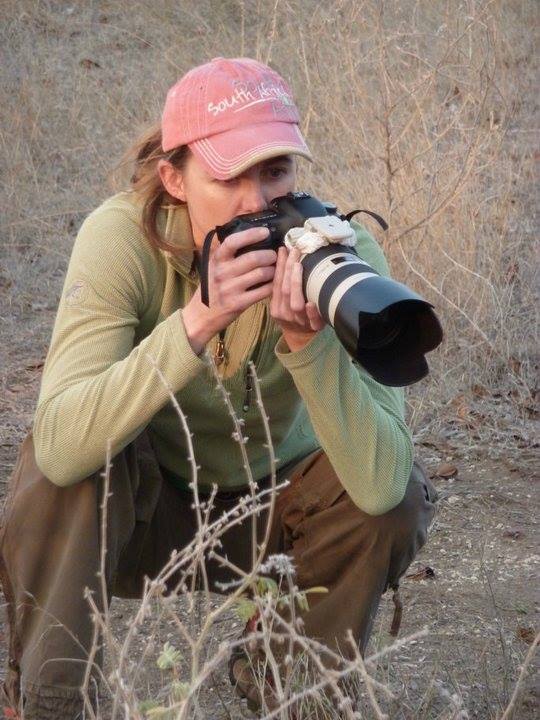
An interview with Hilary O’Leary - Hilary O’Leary has entered one of her stills into the Natural History Museum - Wildlife Photography of the Year Award that has since we published seen an unprecedented amount of support from the public voting in their droves. Please scroll down to view the image, click on the picture and please vote.
Josa - When did you become interested in photography?
Hilary O’Leary - I am fortunate to live in a place which has the most magical things to see and about 3 years ago I realized there was so much more to see when you change the way you view things.. I would say my first interested in photography was about 5 months after I started taking wildlife pictures.. when all of a sudden I felt that wonderful feeling of capturing a great
image. Only then could I see the difference between taking pictures and
photography.
Josa - What’s been your most worked on project and what obstacles did you have to overcome in concluding that particular project?
Hilary O’Leary - My photography is purely a hobby and the only project I could assign to have had has been two or three Photography competitions. So no obstacles yet.
Josa - Whom inspired you to become such a professionally outstanding photographer? I state outstanding as I have viewed some of your past work and you have a great eye for detail.
Hilary O’Leary - I would say I know what I like and have admired and recognized styles throughout all Wildlife Photographers work I have witnessed. I would say the feeling you get when you look at some pictures is what inspires me most.
Josa - I can see you have quite a fondness for African Rhino, do you intend on using your work to fund Rhino projects such as anti-poaching or funding orphanages?
Hilary O’Leary - Yes I love Rhino, only when you have a chance to spend time with them to you realize how innocent and gentle they are. I want to help in anyway I can.
Josa - Rhino poaching has for this year drastically overtaken previous records from 2010, 2011 and 2012 with a near 600 Rhinos slaughtered for fake medicine. How does this make you feel knowing that we could soon see the second largest land mammal banished from the face of the earth and do you have any projects to help sustain Rhino preservation?
Hilary O’Leary - The feeling is - desperate. I can’t help but think the next generation will spend all its resources repairing the damage… But I believe we can make a difference and we will win.
Josa - Can you please explain to our readers what inspired you to take this particular photograph and what sentimental value it has to you?
Hilary O’Leary - The picture was quite incidental as I was driving past and saw a scene.. I only saw what I had captured when I downloaded the images… and the message was so strong. I felt it fitted ” a picture says a thousand words” connotation perfectly.
Josa - Environmental News and Media, Speak up for the Voiceless and International Animal Rescue Foundation Africa have been hosting a youth photography group on-line for the past two years. Do you have any advice, skills or information you’d like to provide to our younger readers that are currently actively involved within youth photography and wildlife preservation?
Hilary O’Leary - I can only say the world is in our hands and there are enough of us to make a difference. I love a quote a read in a different context about training but would like to re-use it here in the war against anti-poaching - its like fighting with a lion… you don’t stop when your tired you stop when the lions tired. We all respond to an image and a single flash of one can stay in our minds
forever… capturing the right images keep the moment real forever and that can change lives!
Josa - What camera and exposure did you use to take this photo pictured above and how long did you have to wait to obtain that pure brilliant shot?
Hilary O’Leary - I use Canon, and it was early morning so light was a little low… 1/200, f2.8
Josa - You have entered this particular piece into the wildlife photography of the year award and since we have published this onto our pages and now ENM site it has generated hundreds of votes and many thousands of shares and likes. Will you be planning on furthering your career outside of your home country Zimbabwe and if so what areas do you plan on working on?
Hilary O’Leary - I have not thought about it… will see what opportunities arrive.
Josa - What’s been your proudest moment in life during this career of photography and why?
Hilary O’Leary - Well it would have to be the current situation, a picture that has created such a wonderful, strong response and a message that has been received correctly.
Josa - On viewing your work past and present I can see that a great deal of patience has gone into perfecting that best shot that has won the hearts and minds of many. Can you describe to our readers just how long it takes you to obtain such outstanding stills, the work that goes into obtaining that perfect still, and how many days and nights have you worked on just one single project?
Hilary O’Leary - I think the time has been spent in recognizing, out of the thousands of images I have taken, which one had the special message. Hours of editing, deleting and searching for a great image..
Josa - What’s been your worst downfall within your career of photography?
Hilary O’Leary - Can’t think right now… I hope its not yet to come either!
Josa - Where do you see oneself in ten years time and do you plan on keeping this amazing work up?
Hilary O’Leary - I hope I will have managed to make, support or assist in the changes we are desperate to see. I hope the success can be measured over years and decades to come. . I hope in 10 years we still have the animals that are so critically endangered.
End of interview.
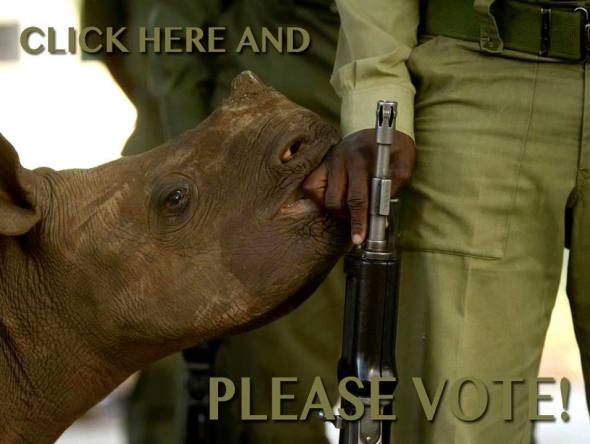
Hilary O’Leary met this little black Rhino whilst spending time at the Malilangwe Conservation Trust in Zimbabwe. The Rhino’s story, however, is not as sad as it might seem. His mother is alive and they are protected by the trust. This image is part of our first ever People’s Choice Award. Since publishing the Hilary O’Leary’s still via our Facebook, Environmental News and Media sites there has been a whopping amount of public support.
People in their thousands have liked and hundreds more have set about voting too. Please don’t forget to vote by clicking on the photo above or by clicking the link here please remember that the closing date for voting is 5th September 2014. Please share this article and ask your friends and family to vote too. The more awareness created of our endangered species the more support can be generated hopefully securing their future furthermore.
Meanwhile in Zimbabwe it has been alleged that Rhino poaching has decreased and Zimbabwe’s Black Rhinoceros population has increased too. The Ministry of Environment, Water and Climate has revealed that there has been a significant drop in Rhino poaching between 2010 and 2013. The African rhino has continued to attract the world’s attention with fears the species might become extinct due to poaching.
In an effort to raise awareness on the need to protect the Rhino species, the country has carried several awareness campaigns. In a speech read on his behalf during the launch of a 500km Rhino Awareness Walk, Minister Saviour Kasukuwere said 52 Rhino were killed in 2010, but the number went down to 38 in 2011 before further decreasing to 22 in 2012.
In 2013, only 16 Rhino were killed.
The black Rhino population has also been steadily increasing from 429 in 2011 to 457 in 2013. The white Rhino species has also increased from 279 in 2011 to 296 in 2013. A professional guide, Sam Nkomo will carry out a 500 kilometre walk from the Matobo National Park to Victoria Falls from the 14th to the 18th of September in a bid to educate communities on the need to preserve the country’s wildlife.
Zimbabwe Tourism Authority chief executive Karikoga Kaseke pledged $1000 towards Nkomo’s walk and urged the corporate sector to contribute towards wildlife conservation awareness programmes. Rhino are classified as endangered on the red list database of the International Union for the Conservation of Nature as their numbers are critically low. Zimbabwe developed a National Rhino Policy and Management Framework for the period 2011 to 2016 in March 2011 in an effort to increase the Black and White Rhino population.
Whilst Rhino poaching has been slowly decreasing in Zimbabwe President Barack Obama United States President has been lobbied by environmentalists to now place sanctions against Mozambique in an effort to curb Rhino and Elephant poaching in other African countries where poaching of both Elephants and Rhino is spiralling out of control. Investigators say substantial evidence exists of Mozambique’s failure to abide by international conventions against wildlife trafficking, including to back up allegations of state complicity.
While President Obama last year mounted a new initiative by the U.S. government to tackle international wildlife trafficking, with a particular focus on ivory, some say Mozambique’s actions are undermining those efforts – and threatening these species worldwide. A new petition, publicly announced that Wednesday, now provides evidence on the issue and urges the president to make use of legal authorities to encourage Mozambique to crack down on poachers.
“Mozambique continues to play an ever-growing and uncontained role in Rhinoceros and Elephant poaching,” Susie Ellis, executive director of the International Rhino Foundation, one of the petitioners, told IPS.
“Although they have been given direction by the international community to enact certain controls, those have been only superficial and have had no meaningful effect. If you look at the large-scale poaching and illegal trade in Rhino horn and Elephant ivory out of Mozambique, it’s directly undercut President Obama’s [efforts] on wildlife trafficking.”
Increasingly working hand in hand with organised crime, poachers over the past three years have killed record numbers of Elephants and Rhinoceroses, particularly in Africa. Some 50,000 Elephants are being killed each year in Africa, alongside 1,000 Rhinos, leaving perhaps as few as 250,000 Elephants in the wild globally.
Driving this illicit market is increased consumer demand in Asia, particularly in China and Vietnam. According to a U.N. report from last year, large seizures of ivory bound for Asia have more than doubled since 2009. The new petition focuses on the central international agreement around wildlife trafficking, known as the Convention on International Trade in Endangered Species (CITES), and warns that Mozambique’s outsized role in African ivory poaching is diluting the convention’s effectiveness. The CITES standing committee is meeting next week in Switzerland.
“Available evidence indicates that Mozambican nationals constitute the highest number of foreign arrests for poaching in South Africa. Organized crime syndicates based in Mozambique are driving large scale illegal trade in Rhino horn and Elephant ivory,” the petition states. (Please sign the petition by clicking the link to your left highlighted)….
“Given the scope and depth of the illegal killing and trade in Rhino and Elephant products by Mozambican nationals, we urge the United States to … enact substantial trade sanctions.”
High-level complicity
Supporters say that strong action by the Mozambican authorities would have a significant and immediate impact on the global supply of illicit ivory.
Officials reportedly estimate that 80 to 90 percent of all poachers in South Africa’s massive Kruger National Park are Mozambican nationals. Local groups say that on most nights more than a dozen separate poaching parties can be prowling the park, most from well-documented “poaching villages” located across the border in Mozambique.
Meanwhile, enforcement of wildlife-related legislation in Mozambique is said to be essentially non-existent, with penalties for poaching and trafficking thus far not effective. Yet changing that situation has been complicated by what appears to be state collusion.
“It’s impossible for that level of illegal activity to be going on without high-level complicity,” Allan Thornton, president of the Environmental Investigation Agency (EIA), a watchdog group based here and in London that co-authored the new petition, told IPS.
“We believe that there are ex-military officials who are providing political protection to the [trafficking] syndicates who are arming and funding these poaching teams. There is substantial evidence implicating both the police and military.”
Mozambique keeps strict control over the types of weapons used by the country’s poachers, Thornton notes, yet such weapons are available to the military. Similarly, police and military uniforms have repeatedly been found in poaching camps.
Thornton says that putting together the new petition took several months, due to the mass of evidence available.
“If all Mozambican citizens were prevented from illicitly crossing over the border, poaching would drop significantly. But there has been no enforcement on the Mozambique side, despite legal obligations under CITES,” he says.
“We believe that the Mozambique government should be held accountable for their activities and act rapidly against these poachers, criminal syndicates and those protecting them. They could close this trade literally in a week.
Unparalleled scope
Thornton says his office is not yet clear on whether the Obama administration has exerted diplomatic pressure on the Mozambique government over the issue of wildlife trafficking. But in filing the new petition, these groups are highlighting the fact that the president does indeed have the legal backing to act on the issue.
Under U.S. legislation known as the Pelly Amendment, the president is allowed to impose trade sanctions if a country is certified to be “diminishing the effectiveness” of an international conservation programme. (U.S. officials could not be reached for comment for this story.)
Further, there is notable precedent under which past determinations – set in motion by EIA petitions – have met with particular success. Two decades ago, for instance, a similar petition was lodged around the trafficking of rhinoceros and tiger parts through Taiwan into China.
That effort resulted in U.S. trade sanctions. Over the following two years, both the Taiwanese and Chinese governments engaged in a broad crackdown on these trades.
“This had a huge impact on reducing demand [for ivory] and reducing the poaching of Rhinos virtually around the world,” Thornton says.
“We saw Rhino populations stabilise worldwide, because two of the biggest markets had closed for demand. This is the same thing we’re now looking for in Mozambique.”
He continues: “And we’re hoping for a particularly prompt response, because the scope of illegal activities we’re currently seeing – where one country is sending hundreds of poachers into another country – is almost unparalleled.”
ALL OUT WAR!
International Animal Rescue Foundation Africa and many hundred more organisations are desperately trying to reduce the Scrooge of Rhino and Elephant poaching that is considered now a war. This war doesn’t just affect Africans or their wildlife. Black market trade of both ivory and Rhino horn is fuelling the trade in firearms and terrorism abroad and within the continent of Africa of which has to be tackled at top governmental level. International Animal Rescue Foundation Africa have been lobbying the United Nations and sent to all (CITES) signatories communications to now support an immediate call for sanctions against Mozambique, Vietnam and China for their failure to reduce both poaching and black market trade. Regardless of what many have stated would actually harm an already impoverished country something has to be done (sanctions must be implemented). While we know poaching and black market trade would decrease sanctions wouldn’t necessarily be spread out over a course of time. So in reality finical harm would be of the lowest. One has to look at it like this. If we lose the Rhino and Elephant, tourism that is a huge money generator would be significantly impacted of which would increase unemployment, crime and anti-social behaviour and leave South Africa that is a modernising country in turmoil financially. We cannot any longer continue to treat the symptoms we have to cure the illness full stop.
Since 2012 the Environmental and Animal Welfare Organisation have sent countless emails and met with a dozen ministers within countries assigned to the (CITES) agreement. Furthermore the Environmental Organisation has been lobbying the United Nations and the British Government to push for sanctions, and to increase military presence from British soldiers not on active service or from the territorial army. Kruger National Park as explained is massive in size and there is simply not enough troops on the ground to fight this war. Training is also needed to now combat the new wave of poachers that are heavily armed and ex-military special forces. South Africa’s ranger units are not equipped or trained in such warfare so training and funding to provide equipment is essential. SNARE the video below was released in 2012 and depicts true real life events, those that comment on Social Media platforms such as Facebook, YouTube, Myspace do not always grasp just how serious this war is. An insight into a rangers life can be seen in last years video release below.
Rangers in the thick of it;
Since the war on poaching began many African ranger and Anti Poaching Units have come under heavy from psychotic rangers. Poachers have also been actively involved in terrorising farmers and individual security services employed to secure our Rhino species. Wildlife rangers endure similar ordeals to soldiers in combat. They routinely face death, injury, or torture from poachers, and the wild animals they protect can kill them too. In the DRC, which has been riven by almost two decades of civil war and political instability, about 150 rangers have been killed in Virunga alone since 2004.
Rangers are exposed to deeply disturbing scenes, with each poached carcass a frustrating and grisly reminder of failure, and they operate in the bush under harsh physical conditions, often with inadequate equipment, pay, and support. International Animal Rescue Foundation this year began phase II of Funding African Wildlife Survival - Operation Equip. This July IARFA have successfully donated $1,111USD to Fund a Ranger - Save a Rhino and donated a further $100USD to the Virunga National Park of which will see a seven man team in combat for a total of one week. F.A.W.S has proven successful since phase II and has already began its phase III Anti Dog Meat Education Operation focusing attention on Liberia the largest African dog meat eating country on the continent.
“Worldwide, about two rangers are killed every week,” says Sean Willmore, president of the International Ranger Federation and founder of the Thin Green Line Foundation, a charity that trains rangers and supports the widows of those killed in the line of duty. “But that’s only partial data,” he adds. “It could be double that amount.” Should Elephant poaching take off in South Africa of which has seen one Elephant poached for its ivory in the Kruger this year we could very well see more rangers shot dead or fatally wounded. Were dealing with heavily armed, well trained and fearless African poachers that will not stop at nothing, especially when a months wages can be earned in a single day.
However its not all doom and gloom. Whilst we all continue to chip in to help those that require more help than IARFA then this war can be won. Rangers are fighting back harder than before. At the start of the year Eleven suspected poachers were killed alone in the flagship national park by SA National Parks (SANParks) rangers and members of the SA Defence Force. Most of the gun battles happened at night after poaching gangs crossed the border from Mozambique. The killing to some may be seen as a godsend however is unfortunately not stopping the bandits from continuing to enter the parks.
Poachers operate in groups of four to six. They are aggressive and engage and shoot at the rangers on sight, creating a daily, life-threatening situation. SANParks said in a statement it was “appealing to the South African public to support efforts by rangers to stop the mass killing on both sides.
Concluding;
International Animal Rescue Foundation Africa has been actively involved in helping to reduce poaching in many ways. Investigating corrupt professional hunters then passing the evidence on, engaging small Rhino ranches pushing funding and equipment to staff on the ground that have literally nothing to defend themselves. Lobbying (CITES) signatories, the United Nations and British Government to now impose and support an immediate temporary sanctions against Mozambique, Vietnam and China. Furthermore we are supporting a no trade in Rhino horn and are venomously pushing and succeeding to now ban Rhino hunting across Africa where Rhino populations are still extant. When the demand stops the poaching will too.
Thank you for reading and please do not forget to vote for Hilary O’Leary Wildlife Photographer.
Dr Josa C. Depre
www.speakupforthevoiceless.org
Chief Environmental Officer
Environmentalism Chapter 44 - Habitat Fragmentation
Habitual fragmentation is now the leading cause of concern regarding the nearing extinction of animals to colossal destruction of forests totalling exactly 80% of our flora and fauna internationally. This total is vast in size and there seems to be no decrease or plans implemented by governments to now slow the ever increasing environmental carnage down that’s killing and displacing many species of large and small mammals to tree‘s plant‘s, insects and micro-organisms that reside on 22.29% of the earths surface and 70% marine to fresh water. A total coverage of 196.9 million square miles of earth to date is under threat.
Habitat fragmentation is not being professionally addressed by government environmental agencies, ministries of water and affairs, transport authorities to public health. The Ministry of Defence too could also play a pivotal role in reducing environmental carnage that could cut human displacement down on a massive scale, by, “talking” instead of sending war head’s and troops to nuclear armed nations.
Conflicts only destroy more land, displace animals and human’s taking decades to rejuvenate these areas and increase economy thus decreasing crime. By this time the species of animals within these area’s have already been pushed to extinction. The Malian Elephant is now being poached although in small numbers due to their fairly small tusks as of the retched poverty stricken refugee camps that are set up when war occurs. Wildlife crime is seen as one of the only incomes.
Raging war’s regrettably displaces innocent civilians and animals caught in the middle of conflict zones thus moving them onto non-human non-habituated land that in turn pushes species of animals into other areas starting the ecological destruction circle of again, causing human and species conflict, thus increasing the destructive illegal wildlife trade ranging from Elephant’s to Rhinoceros, and Wild Felids to forests completely uprooted killing thousands of animals and medicinal plants.
Medicinal plants are important to both human and [animal] health of which also reduces the need for more species of primates, canines, felines to many more animals mostly domesticated being forced into a life of complete misery within experimental laboratories from which scientist’s and pharmacologists, to neurologists trial synthetic medication on.
The need for natural medicinal plant’s is so important within human and animal health too as they lack side affects of which “synthetic pharmaceuticals medicines” such as Dixarit, Chlorpromazine, Aripiprazole, NAISDS and more cause many secondary side effect’s within the human body, mostly gastrointestinal and central nervous system.
Knowing that habitual destruction and climate change that’s now more commonly known as “global cooling” is indeed affecting our environment and it’s natural inhabitants one would of believed that the not so caring government’s would now take this matter of serious concern up. However they are treating it as a taboo subject to merely passing the problems of on to non-profit and non-governmental rescue organisations and environmental units, universities and scientists alike that are struggling with public funding as it is or simply cannot cope with the spurge of destruction just for one species alone.
Picture below shows populations of Tigers and the historical loss of habitat that is now affecting many wild Tiger populations that are estimated in all at a depressing 3,600 if that. The Amur Tiger is only listed as 39 and has not been viewed within the wild for many years now feared possibly extinct. The Sumatran Tiger’s populations are decreasing because of palm, paper and pulp trade currently populated at a mere 500 although the last population census showed a “slight” increase since environmental investigations began within the area of Malaysia and Indonesia that had been conducted with the RSPO working to now eliminate violating companies although this is a very slow and costly process.
Habitat Fragmentation simply is;
Habitat fragmentation, as the name implies, describes the emergence of discontinuities (fragmentation) in an organism’s preferred environment (habitat), causing population fragmentation. Habitat fragmentation can be caused by geological processes that slowly alter the layout of the physical environment (suspected of being one of the major causesof speciation, or by human activity such as land conversion, which can alter the environment much faster and causes extinctions of many species.
There are many other factors that are responsible for habitat fragmentation too that are listed below;
Human overpopulation - 1960 saw an estimated world population size of only 3 billion in 1960, moving up to 1980 saw 4.65 billion. The increase really took of in 1995 at 5.47 billion persons then increased per five years of 1 billion more people. 2000 saw over 6.9 billion person’s with 2011 at 6.97 billion. 2012 saw an estimated whopping 7.9 billion with 2013 now standing at an estimated 8.1 billion (2013 still has to be officially tallied). The increasing figures though are not on the decline and every day see’s a rough estimated figure of 250.000 to 300,000 people born into the world.
Agriculture is also playing a massive role in habitat depletion. Looking at governmental data the total amount of square kilometres of land that was being farmed for 1961 stood at 38.93 million square kilometres. From 1961 the increase was rather slow although still noticeable that saw in 1975 39.58 square kilometres of land farmed displacing many species and killing of much green belt land and forest’s. Then the real uphill hike was viewed.
From 1985 the total land farmed both arable and cattle skyrocketed from 41.66 million square kilometres, to 1995 that stands at 49.38 million square kilometres farmed. The increase took of from 1991 shooting up to 1992 at almost 50 million square kilometres of land farmed for the entire planet. The only real small decrease was viewed in 2003 at 49.2 million square kilometres and from then on to date the total land farmed for the entire planet has fluctuated that stands at for 2013 50.1 million square kilometres farmed of land. The figures above are at “correct levels” now take a look again at the size of the earth that is “inhabitant by human and animals” standing at 22.2% exactly 196.9 million square miles of earth . We are most certainly looking at half of the worlds land taken by agriculture being the number one contributor to climate change/cooling, deforestation, habitat depletion, human species conflict, pollution, species extinction and more.
Evidence of habitat destruction through natural processes such as volcanism, fire, and climate change is found in the fossil record. For example, habitat fragmentation of tropical rainforests in Euramerica 300 million years ago led to a great loss of amphibian diversity, but simultaneously the drier climate spurred on a burst of diversity among reptiles.
The great causes of concern for habitat depletion known as fragmentation should be noted
Land clearance for roads and building’s.- Two such continents spanning from Kenya to Tanzania that boast’s a colossally high 1.5 million hectares of land in Africa holding an abundance of native and non-native mammals and non-mammalians is the Serengeti of which a massive stretch of land is now being looked into to plough an unnecessary road through that will not just see many animals murdered by speeding traffic, but migration route’s effected, slowed down, but most importantly the road is opening the land up for easy access to poachers and hunters.
Palm oil and on-land static oil drilling - Listed above as land clearance to, palm oil plantations both sustained and non-sustainable are playing a pivotal role in reducing wildlife such as the Bengal and Sumatran Tiger, Pygmy Elephant, to Orang-utans and many smaller primates, avian and reptilian species. Natural forestry is being reduced on a massive scale of which should both the palm oil and pulp and paper trade not decrease then 80% of all green forestry land from Indonesia, Malaysia, China to North and South America will lose thousands of animals, plants and trees from both palm oil and greed for demanding oil and petroleum want by governments and industries wanting to a quick buck.
Rural development/Urbanization - Housing has increased dramatically from 1960 to 2012 and that can clearly be seen by looking at the colossal levels of human overpopulation recorded by the (WHO) World Health Organisation and United Nations Environmental Programme (UNEP). There can be no official data actually seen for the “entire planet” with regards to rural development as not every nation undertakes an annual or five yearly census such as the United States of America and the United Kingdom for example. The estimated number of homes upon the planet from 2012 stands at 2.0 billion. To date and increasing rapidly.
One must also take into consideration that whilst wars are raging, poverty is increasing, and human rights are being updated of which more people are going to require homes from which a rough estimated tally of homeless people for the entire planet stands at 100 million (Still not re-homed). Add that to the 2.0 billion for the average 2-4 bedroom family homes and we’re looking at gargantuan problems with habitat depletion now and within the on-coming future decades. - The most depressive factor is urbanization. By 2050 it is predicted that 64.1% and 85.9% of the developing and developed world respectively will be urbanised. So in theory and looking at the statistics scientifically we are almost over 70% of land usage inhabited by many species internationally used [just for humans] and there is still no signs of decrease that the governments are “failing to acknowledge” to even taking seriously.
Transport and highways - 4.7M roads on 6% of the worlds’ land surface), this amount’s to around 80,000,000 roads. The more auto-mobiles and increase in population then sadly this figure is going to sky rocket rapidly. Roads are being built internationally on a vast scale depleting small rodents, reptiles, organisms, ripping up hundred year old trees, and, forests displacing avian species and bats that are most important to the ecological system.
Picture below shows how habitat fragmentation appears in the eyes of the wildlife that’s just had their homes removed. What would YOU do if someone now tore through your city in this manner leaving a trail of destruction? You would most likely go berserk. Can you understand why we become so angered at irresponsible humans that are not just Hippocratic they also destroy anything that lives that is merely not human. “Animals in some human’s lives” are simply least important. You can stop this however are you, that’s the question? Or are you prepared to view the “factual” 109.09 million square miles of earth destroyed for your children and their children to live within a concrete jungle with no wildlife? You wouldn’t treat you family in this way, so why treat Mother Nature like it?
The following data below is simply for 2003 of which shows a massive coverage of road surface that is in “miles”.
US - 3,905,000 total miles
Mexico - 153,000 miles
Canada - 528,000 miles
UK - 225,000 miles
Sweden - 85,000 miles
Germany - 395,000 miles
France - 504,000 miles
Japan - 704,000 miles
International Animal Rescue Foundation has applied for an up to date census from the top ten largest continents regarding road coverage so that we can formally update this thus working out mathematically exactly how much land has been depleted that’s pushing animals from their homes and uprooting green belt land, forests and more.
The depressing depletion of other land’s must also be noted as below.
The creation of hydroelectric reservoirs. Habitats which were once continuous become divided into separate fragments. After intensive clearing, the separate fragments tend to be very small islands isolated from each other by cropland, pasture, pavement, or even barren land.
The latter is often the result of slash and burn farming in tropical forests. In the wheat belt of central western New South Wales, Australia, 90% of the native vegetation has been cleared and over 99% of the tall grass prairie of North America has been cleared, resulting in extreme habitat fragmentation.
By 2100 we are seriously looking at an estimated 80-85% of animal land literally vaporised or human use and production unless professional controlled and monitored sustainable agriculture, urbanization, ruralisation is implemented with immediate effect to decrease this copious out of control destruction down.
Should immediate action not be taken to reduce vast habitat fragmentation then we will be looking at a 100.10% of the earth’s “land” left. This is based on scientific mathematical and environmental analysing of current and past trend’s from governmental, organisational, and industry past and present data.
Habitat fragmentation is serious and it will effect more of our larger species of animals first plus land that is non-human habitable such as forests and green belt land.
How does habitat fragmentation effect our nature though?
Habitat fragmentation in all aspects as defined above effects all flora and fauna both large scale and small, by pushing the species to extinction to forcing them into other inhabitant areas that then “moves them species on” effects the ecological cycle greatly or creates “species on species conflict”.
Habitat depletion also has unwanted effects for both animal and human by pushing the species into “rural or humanized areas” from which we then see human species conflict” as the species natural source of food has been destroyed because of human negligence and greed, demand and want.
Regrettably the animal’s are then punished most likely by being shot to death or recently within India we have seen since 2011-2013 a spurge of Leopard’s, Tiger’s and Bears roaming into rural areas looking for food thus tragically seeing conflict and sadly fatalities.
The animals are always seen as a threat in most cases and this is an area that International Animal Rescue Foundation’s Environmental teams within New Delhi are working to help as best they can utilising new technologies, educating and making aware in the rural areas out of the city on how to preserve the natural environment, working to now install communication’s that will alert prepared forestry rangers/or/ trained certified villagers with tranquiller rifles, to teaching and demonstrating what not to do and what to do in the event of a wild animal such as Tigers, Bear’s and other big cats roaming into “humanized zones”.
Picture above shows Wilder-beast and Zebras migrating through the national parks that also move through the Serengeti Should the road be built scenes such as this will simply be destroyed. Take action now and sing the petition here http://www.avaaz.org/en/save_the_maasai/
Working and communicating with forestry rangers and the governmental environmental departments we must clearly demonstrate and encourage professional wildlife management instead of taking the laws into one’s hands. Boundary fences, canopy trip nets, cell’s and even camera traps, double two way mirrors and much more are being utilised as best we can to preserve wildlife thus reducing extinction, whilst educating on the do‘s and don’ts.
Until we start an official funding programme for this particular phase of wildlife management then the programme will still only run slowly yet effectively and professionally. The last call came yesterday when enough was enough for us of which we received the most heart breaking news of two Bear cubs and one Mother cub plus eight humans murdered.
Sadly ignoring this area end’s up with both animal and human fatalities that could and can be avoided. Only Yesterday within a rural poor district of India (May 9th 2013) we was informed of two bear cubs that had strayed into a humanised residential area in search of food. They where caught then set on fire. Mother Bear then retaliated some days later which the park wardens took over eight days to take action on.
Eight people were killed by the Bear with the Bear later beaten to death by the angry mob of villagers. We are seeking action on this and will not allow this tragic accident and animal abuse to drop until those that were responsible for the killing of the two Bear cubs are brought to justice. Both animal and human life could have been preserved had the correct procedures been adopted instead of using and acting upon anger and rage.
Asiatic Lions, Orang-utans, Pygmy Elephants, African Elephants and African wildcats are also under attack as they again are either roaming within residential area’s, or farms looking for food that would normally of been within their own home. With no homes, and no food source then unfortunately they are tragically treated as pests. Traps and poisons are laid down thus seeing these species plundered further into extinction.
Asian and African Elephants are taking a serious battering from both the illegal wildlife trade as well as hunted as the hunter still believes “there are to many of them that are causing damage to one‘s land”. This is complete nonsense and should the hunter look further a-field and not use the “sustainable living” weapon then possibly we could all work together to now help these species before they are all pushed to extinction.
Our ecological world both plant and mammal to non-mammal, marine and micro-organisms are of the utmost important to us and Mother Nature. Should we lose our big five of Africa, wild felids, Whales, Dolphins, Seals and more all because of human negligence then we have seriously failed Mother Nature.
Failing to take the mass depletion of land seriously will eventually turn humans on to humans killing all of mankind and the most sensitive animal kingdom. For more information on how you can help you can contact us here at info@international-animalrescue-foundation.org.uk
International Animal Rescue Foundation.
All rights reserved, all “names” of the Foundation and Speak Up for the Voiceless belong to the us of which no copying or transmission, abuse of our organisational “names” is permitted. 2013.
Act or view forced action to preserve our environment and children - Thank you
Environmentalism - Chapter 37 Endangered Species Watch
When the Conference of Parties 16th meetings was hosted in Bangkok, Thailand on the 4th March 2013 by the Convention on International Trade in Endangered Species of Wild Fauna and Flora, also known as the Washington Convention attended by some one hundred and seventy seven nations we believed that Cites would instigate with immediate effect the safe guarding and preservation of some of the worlds most endangered and critically endangered to nearing extinct species of both flora and fauna that are mostly located and distrusted within Africa and Asia, with the Amazonia rainforest and now Antarctica under serious threat from both poacher’s to hunting and the search for oil, and environmental carnage.
We and other organisations are still awaiting for direct and imminent action to now bring under control the colossal poaching epidemic that is seeing some hundreds of animals slaughtered for the illegal wildlife trade feeding the Traditional Chinese Medicine market’s, aiding cultural and religious beliefs to funding the war on terrorism. Furthering this we have still yet to view any formal positive actions to regain control of the catastrophic implications of atmospheric environmental carnage and climate change.
The global clock is ticking, and since the CoP 16th meetings there has been an unprecedented surge in the amount of poaching of which we can only believe is due to “possible or nearing sanctions that could be implemented” on African and Asian nations should they not take firm and decisive action to quell this destruction immediately.
So we look at some of the worlds most endangered species that are listed below hoping soon that Cites and other larger Non-Profit Organisations along with United Nations Environmental Department and (WHO) The World Health Organisation, and the International Union for the Conservation of Nature now start to initiate what was preached at the meetings to safe guard and preserve our species before we see by 2050-2100 the entire species listed below pushed from extant to extinction.
One must also remember that were not just working with the preservation of mammalians and aquatics too, looking within Malaysia and Indonesia to Amazonia and the Antarctic atmospheric pollution, shifting ice plates, habitual destruction, plantations of artificial rainforests for palm oil production and manufacturing, agriculture to deforestation and illegal logging is also another disquieting yet prodigious quandary that the entire environmentalist and activist movement “must confluence immediately” for the sake of our younger generation and theirs to come.
Species of concern;
Gorilla
Populations: Listed to date: Listed below
Located deep within central Africa the Virunga National Park in eastern Congo holds the diverse species of Gorilla. The entire species are under threat from habitual destruction, civil war, and honour killings, to the illegal charcoal trade, bush meat and illegal exportations to African Zoological Gardens.
Eastern Lowland Gorilla – See’s a population rate of just less than 3000
Mountain Gorilla – See’s a population rate of just less than 720
Western Lowland Gorilla – See’s a population rate of just less than 100,000
Cross River Gorilla – See’s a population rate of just less than 300
Please view the video documentary; - Please note the video below may not be available in your nation. The title the video is Gorilla Murders - Virunga National Park that is hosted by National Geographic. Alternatively one can view the other documentary below on Mountain Gorillas.
Sumatran Orang-utan
Populations to date: 7,000
The Sumatran orang-utan is the more endangered of the two orang-utan species. Found only in the northern and western provinces of Sumatra, Indonesia, the species is fast losing its natural habitat to agriculture and human settlements.
Palm oil plantations and species encroachment onto human land looking for food that was once within their homes sadly view’s the species attacked or murdered. They are also considered pests within the plantations workers eyes of which poisons and traps are laid “which is difficult to prove whom is to blame” that regrettably also hinders their survival. There have also been reports of illegal tropical pet trade and zoophilic sexual attacks.
Mountain Gorilla
Population to date: 720
The mountain gorilla became known to science on 17 October 1902, and is a subspecies of eastern gorilla. Although explained above we are seeing a rapid decline in numbers within the Congo region better known as the Democratic Republic of Congo (DRC). Since the early 1990s civil war has destroyed much of the mountain gorilla species along with its habitat from the illegal trade in charcoal. Unfortunately we also see the mountain gorillas used sporadically within the Traditional Chinese Medicine market too.
Atlantic Blue Fin Tuna
Population information: Species is estimated to have declined at least 51% over the past three generation lengths (39 years) and is listed as Endangered under Criterion A2. In the Eastern Atlantic stock, current fishing mortality is far above maximum sustainable yield (MSY) and estimated SSB is far below MSY.
Atlantic Bluefin Tuna – Tuna is perhaps the most high profile victim of unregulated and uncontrolled overfishing. Bluefin tuna populations have declined alarmingly over the past few decades. Europe and International Continents were all warned that should over fishing and non-moderation of stock mainly that of the “young” not be controlled or enforced then we would view a humungous depletion of tuna stock levels. Only now when the species has almost been pushed to extinction have nations finally taken notice.
Atlantic Blue Fin Tuna’s main threats are over fishing, the use of mass trawler drag nets, pollution, climatological change and marine temperatures fluctuating. Atlantic Bluefin tuna spawn just once a year and do not reach reproductive maturity until they are 8-12 years old. This makes Bluefin tuna more vulnerable to overfishing than some of the smaller tuna species that can spawn several times in a year. Female Atlantic Bluefin can produce up to 10 million eggs per year, but just a small fraction survives to adulthood
According to information collected by the International Seafood Sustainability Foundation (ISSF), the Eastern Pacific stock of yellow fin is overfished and some overfishing is occurring in the Indian Ocean. The northern and southern Atlantic Ocean stocks of albacore are also overfished. The skipjack tuna, while quite resilient, could easily slip into a vulnerable state due to overfishing if improperly managed.
Big eye tuna are prized in Asia for sashimi as well as frozen and fresh in other markets. As Bluefin tuna populations shrink around the world, pressure on big eye fisheries is increasing. According to information collected by the ISSF Scientific Advisory Committee, overfishing is occurring in Eastern and Western Pacific Oceans. Bluefin tuna populations have declined severely from overfishing and illegal fishing over the past few decades –not just Atlantic Bluefin tuna, but also Pacific Bluefin tuna and Southern Bluefin tuna. Population declines have been largely driven by the demand for this fish in high end sushi markets.
Illegal fishing of Atlantic Bluefin tuna is a big problem and the fishery has been plagued by lack of enforcement and control.
Leatherback Turtle
Population to date: Females 2,400 (Total population including females 34,000)
The leatherback turtle has survived for more than a hundred million years, but is now facing extinction. Recent estimates of numbers show that this species is declining precipitously throughout its range.
Leatherbacks and their young have taken a vast battering over the past ten years with more Turtles pushed further to extinction from 2010-2013. The Costa Rican government simply allows the eggs of this reptilian to be dug up from the breeding grounds of which their eggs are then sold in the hundreds of thousands to Asian black market peddlers.
The Leatherback also faces gargantuan threats from trawler nets and pollution to also being poached for “Turtle soup” mainly used as a pseudo aphrodisiac within most continents of Asia.
Tiger – Sumatran – Bengal – Siberian
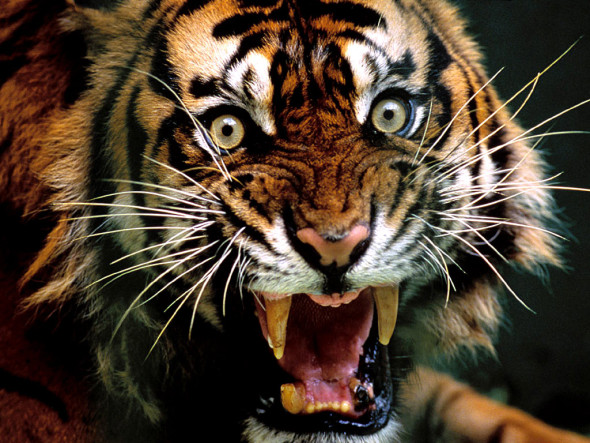 Population to date: 3,200+ Amur 300 (If that)
Population to date: 3,200+ Amur 300 (If that)
Less than 3,200 remain in the wild, we have lost 97% of our wild tigers in just over a century. The tiger population faces a number of threats from illegal poaching, habitual destruction caused by over population and palm oil trade within Indonesia and Malaysia, India, China, Thailand and Russia being the main number one continents form which we believe that we are going to see them banished within the next two or three years unless the Asian and Russian environmental departments to law enforcement do not take immediate action.
The Tiger population is mostly hunted for its pelts (skin) that can fetch once processed some $100,000 on the black market. Tiger penis soup, Tiger claw, to just Tiger meat is all used within the Asian medicinal market with Tiger bone wine deriving from Tigers that have been breed within Chinese (hell holes) then left to starve. The Tigers are then slaughtered or die an agonising pain from malnutrition of which the entire carcass minis the pelt and some flesh is placed within the a vat of rice wine to produce the illegal Tiger bone wine that can fetch some $10,000 and upwards on the Asian black market.
Snow Leopard
Population to date: 5700
Snow Leopard – There are up to 6,000 snow leopards in the wild across 12 countries, but its numbers are gradually declining, with hunting and habitat loss just some of the reasons that it is endangered. The WCS Wildlife Conservation Service also sent ourselves a census that they carried out on military troops that had also been purchasing “some” Snow Leopard parts not actually realizing from camp markets and of camp markets within Afghanistan, Pakistan, and Eastern Russia. They have all since been educated on the illegal wildlife trade with much thanks and appreciation to the WCS for undertaking this survey.
The Snow Leopards habitat is under extraordinary pressure from climate change, and over grazing of cattle such as Elk that are pushing the Snow Leopards prey further away as of “their own prey’s” food source being depleted. The Snow Leopard is mostly hunted for its pelt (skin) that can fetch many thousands on the black markets that then subsidise the war on terrorism.
Vaguita
Population to date: 500-650 (If that)
(Last population was under 200, however conservation efforts have increased their numbers)
The Vaquita is a very small porpoise that lives solely in the Gulf of California, Mexico. The species is critically endangered primarily as a result of entanglement in fishing nets.
The vaquita’s population has been in decline since at least the 1940s, and could be declining by as much as 15% each year. At current rates, the vaquita population may be reduced by more than 80% over the next 10-30 years and is in danger of extinction.
Commercial fishing is by far the greatest threat to individuals, their habitat, and the species overall survival. In the 1920s, a commercial fishery using gillnets for the now-endangered totoaba (a large sea bass) was established (Reeves et al. 2002). While the commercial fishery for totoaba ceased in the 1970s, other fishing still continues. Vaquitas are incidentally taken as “by catch” in local gillnet and trawl fisheries. It is estimated that at least 30-85 individuals are taken incidentally each year. Other possible threats to this species include environmental pollution, habitat degradation, and inbreeding due to low population numbers.
Irrawaddy Dolphin
Population to date: 7,000-8000
Irrawaddy Dolphin – Some populations are close to extinction such as those in the Mekong River and Malampaya Sound in the Philippines. The main threats are from fisheries by catch and habitat loss. Although the Irrawaddy dolphin is not directly exploited, it is exposed to incidental mortality in fisheries (e.g., gillnets in Australia and in Malampaya, explosives), the principal cause of depletion. Habitat degradation due to development of dams, deforestation and mining also continue to undermine the species to a lesser extent.
The small population of the Mahakam River (Indonesian Borneo) and possibly that of the Ayeyarwady River (Myanmar) are also live-captured for display purposes.
Javan Rhinoceros
Population to date: (Currently unknown) however reports this March 23rd showed that the Javan Rhinoceros is still present with us confirmed by WWF (World Wildlife Fund) within an undisclosed location of which we are not placing any geo-geographical location for security and preservation reasons. We can confidently quote though that 25 have been documented although it was at first only a family of five. This number has now increased from camera traps installed at key location points within (un-named) areas and continents.
The current threats to the Javan Rhinoceros a ten million year old prehistoric dinosaur that is a little smaller than the White and Black Rhinoceros are habitual destruction from deforestation, pulp and paper trade to palm oil too, climate and pollution carnage are also causing mass loss of life with poaching always the ultimate number one factor in this region to any that the Rhinoceros “species” populate.
The Javan Rhinoceros just like the Indian one horned Rhinoceros, White Rhinoceros and the Black Rhinoceros are regrettably poached for counterfeit Asian traditional pharmaceuticals that do not under any circumstancescure diabetes, cancer, headache, migraine, AIDS (Auto-Immune Deficiency Syndrome or HIV) improve sexual arousal, libido, erection, tachycardia, hypertension, skin disorders, dermatitis, opiate withdrawal, nor does the Rhinoceros horn help with conception, help to quit smoking, nausea, vomiting, ADHD, ADD, or any other form of neurodegenerative disease.
Rhinoceros horn does not and never did cure cancer in any Vietnamese government member’s wife which was a complete compulsive lie. Rhinoceros horn does not cure physiological or psychiatric illness.
The horn of Rhinoceros is made up of mainly Keratin that is more related to Cockatoo beak, Parrot beak, or Horse hoof, the horn also contains a combination of non-active non-medicinal properties from phosphorus, nitrogen, calcium, keratin, and compacted hair.
Rhinoceros horn is similar, but not identical, in chemical composition to water buffalo, cattle and yak horns, which are frequently used to “substitute” for rhinoceros horn in traditional medicinal formulas.
Rhinoceros horn has not been well researched in comparison with other ingredients in traditional medicine. Only one study was found (2012) testing rhino horn for pharmacological effect in humans using the best-practice method of a randomized double-blind trial. That study found a short-lived significant effect on fever in children, but did not recommend its use as acetaminophen (a common nonsteroidal anti-inflammatory drug) performed better.
More testing has been done in the laboratory, using lab animals as well as in vitro techniques. Most of these studies have been done in China, where rhinoceros horn is permitted to be used in research only to identify viable substitutes for it, and all found statistically significant pharmacological effects for rhino horn: anti-pyretic, anti-inflammatory, analgesic, procoagulant, among others.
The same studies also found significant pharmacological effect for animal horn substitutes. In contrast, two studies done outside Asia (in the UK and South Africa) found no pharmacological effects at all for rhino horn or other animal horns; significant effect was found for some traditional medicinal plants tested which were being explored as potential substitutes for rhinoceros horn.
A few different suggestions as to which components of rhino horn might be responsible for the observed pharmacological effects have been put forward, although the potential mechanisms of action were not elucidated.
Worldwide population 22,200 (Not confirmed within Africa of which the last census was undertaken in 2010 quoting a number of 18,800) However with the current poaching increase and demand taking into account the gestation period using mathematical studies shows a total of no more than 15,500 of which ¼ of South African Rhinoceros are owned on private farms and reserves. http://www.cites.org/eng/com/sc/62/E62-47-02-A.pdf
Population to date for the Indian One Horned Rhinoceros: 2,000 and rapidly decreasing within the Assam National Park.
Please note there are no more Javans within this national park -
Asian Elephant
Population to date: 20,000 and declining
Sacred but exploited, the Asian elephant has been worshipped for centuries and is still used today for ceremonial and religious purposes.
ILLEGAL WILDLIFE TRADE
Even where suitable habitat exists, poaching remains a threat to elephants in many areas. In 1989, the Convention on International Trade in Endangered Species of Wild Fauna and Flora (CITES) banned the international trade in ivory. However, there are still some thriving but unregulated domestic ivory markets in a number of countries which fuel an illegal international trade. Although most of this ivory comes from poaching of African elephants, Asian elephants are also illegally hunted for their ivory, as well as for their skin. In some countries, political unrest is disrupting anti-poaching activities.
GENETIC THREAT
Conservationists are concerned that a loss of male big tuskers due to poaching could lead to inbreeding and eventually to high juvenile mortality and overall low breeding success. The loss of tuskers also reduces the probability that these longer-living lone males will mate and exchange genes with females of different sub-populations.
CAPTURE OF WILD ELEPHANTS
The capture of wild elephants for domestic use has become a threat to some wild populations, seriously reducing some numbers. India, Vietnam and Myanmar have banned capture in order to conserve their wild herds, but in Myanmar elephants are still caught each year for the timber and tourist industries or illegal wildlife trade. Crude capture methods often result in elephant deaths. Efforts are being made not only to improve safety, but also to encourage captive breeding rather than taking from the wild. With nearly 30 per cent of the remaining Asian elephants in captivity, attention need’s to be paid to improve care and targeted breeding programs.
HABITAT LOSS
The main threat facing Indian elephants, like all Asian elephants is loss of habitat, which then results in human-elephant conflict. In South Asia, an ever-increasing human population has led to many illegal encroachments in elephant habitat. Many infrastructure developments like roads and railway tracks also fragment habitat. Elephants become confined to “islands” as their ancient migratory routes are cut off. Unable to mix with other herds, they run the risk of inbreeding.
Habitat loss also forces elephants into close quarters with humans. In their quest for food, a single elephant can devastate a small farmer’s crop holding in a single feeding raid. This leaves elephants vulnerable to retaliatory killings, especially when people are injured or killed.
TOURISTS PLEASE DO NOT VISIT THESE PARKS - YOUR MONIES ARE KEEPING THIS TRADE GOING DON’T FEED THE TRADE - PRESERVE THE SPECIES.
For more information or to ask for a species to be added to the Endangered Species Watch please contact us here http://www.international-animalrescue-foundation.org.uk/general-enquiries/
Director and International Delegates and Ambassadors
Environmentalism Chapter 30 - CoP 16 Report on Wildlife Crime
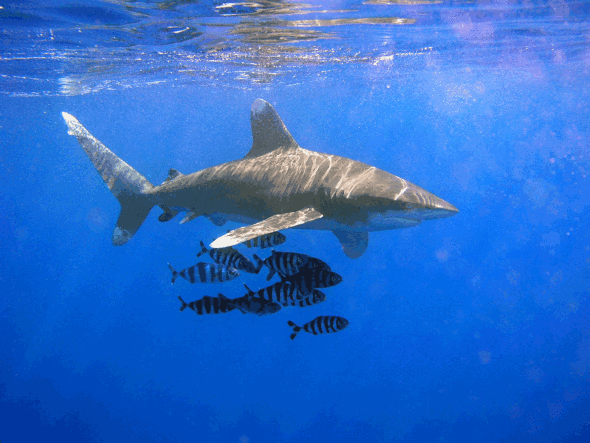
International Animal Rescue Foundation © is pleased with the overall majority of the meetings at the 16th conference of parties (CoP 16th) held in Bangkok, Thailand from the 4th March to the 14th March 2013, although a handful of critics state otherwise regarding Tiger, Elephants and Rhinoceros, Polar Bears and other species listed within the 34,000 species that are brought up within the meetings every three years.
We are though somewhat disappointed in other decisions of which Asia was seen to group mostly together with nations that deal in illegal ivory, Rhinoceros horn but mostly illegal weaponry taking most of the floor.
Convention on International Trade in Endangered Species of Wild Fauna and Flora), also known as the Washington Convention adopted in 1963 and then consequently signed March 3rd 1973 by the then 177 nations which some sceptics seem to be forgetting Cites are not law makers as such. Cites is simply a “signed agreement” that consisted of 177 parties or countries with the majority of them nations from the European Union with one new nation entering four days that now consists of 178 parties in total.
Cites and the IUCN’s aim is to ensure that international trade in specimens of wild animals and plants does not threaten the survival of the species in the wild, and it accords varying degrees of protection to more than 34,000 species of animals and plants.
In order to ensure that the General Agreement on Tariffs and Trade (GATT) was not violated, the Secretariat of GATT was consulted during the drafting process. The agreement has also as of the 40th anniversary implemented and founded new adoptions such as task forces M.I.S.T from which nations will now work on forming an international conservation rescue unit to combat illegal poaching, pseudo hunting, illegal wildlife trade in plants and animals to the preservation of our water ways, soil and natural environment.
Should a serious event of poaching or natural disaster happen placing species in critical danger of extinction or other then transnational agencies will reach out to help other continents in dealing within in a multitude of tasks of which will be effective we hope within the next forty days. Forwarding on from the 15th March 2013, new Deoxyribonucleic acid laboratories will be set in place and internationally recognised departments dispatched and organized to now hit poaching and wildlife crime harder than before, although this is going to take some time to establish we will await and view what the outcomes of M.I.S.T and how effective other orders implemented will come about.
Cites and the International Union for the Conservation of Nature DO NOT see “hunting as a crime” or major problem from which it clearly explains that “sustainable utilization” to protect species is a must as explained in part of their mission statement above to not threaten the survival of the species in the wild http://www.cfr.org/natural-resources-management/convention-international-trade-endangered-species-wild-fauna-flora-cites/p21750 http://www.iucn.org/about/union/commissions/cec/cec_how_we_work/
Sharks, Tiger, Elephants and Rhinoceros;
Much confusion is floating on the international networks that Cites has been caught with its pants down as is only thinking of monetary gain, this is complete utter nonsense. CITES is an international agreement to which States (countries) adhere voluntarily. States that have agreed to be bound by the Convention (‘joined’ CITES) are known as Parties. Although CITES is legally binding on the Parties – in other words they have to implement the Convention – it does not take the place of national laws. Rather it provides a framework to be respected by each Party, which has to adopt its own domestic legislation to ensure that CITES is implemented at the national level.”
In laymen’s terms each nation has to engage in protection of some 34,000 species from which they can ignore such as most of Asia has. However should the “signed parties” FAIL then sanctions can and will be placed of which evidence is shown by the nation’s effected to those that are want action or are concerned with crime in their continent.
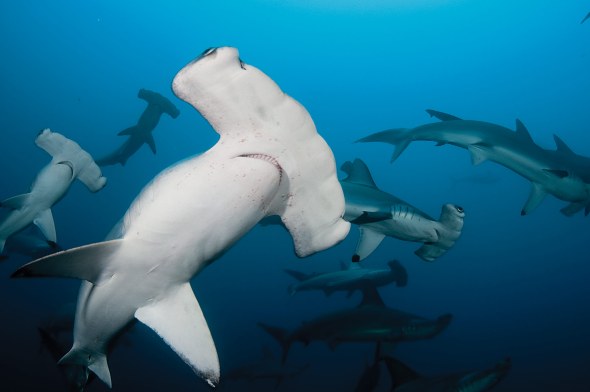
The states then voluntary agree by VOTING that sanctions will be implemented. By applying these sanctions this then BANS the aggressor nations from importing, or exporting any of the listed 34,000 species of plants and animals that would see the violating the nations revenue hit drastically.
Sharks
The 16th meetings of the Conference of Parties (CoP) finally after much debate and disapproval by Asia and some African nations, listed the Ceanic White-tip sharks, three species of Hammerhead Sharks, Scalloped Hammerhead, Great Hammerhead, and Smooth Hammerhead, Porbeagle sharks and manta rays. We are very pleased by this as some 100 million Sharks and Rays a year are slaughtered for their fins to produce Asian Shark Fin soup and Traditional Chinese Medicine.
Had this very historical move by all nations not of been implemented then the Sharks explained above would have been pushed to near extinction from over fishing, poaching, hunting, and the Traditional Chinese Medicine trade which in turn would also have seen a mass over population of their prey thus placing more small species of marine aquatic life in danger we would also of seen a colossal loss of such amazing species effecting marine biodiversity more.
Asia are the main number one offenders and should such nations NOT abide by the ruling that will come into place after the honey moon period of 40 days then sanctions could be placed at any alternative meetings plus17 Conference of Parties (CoP) thus seeing ALL trade banned.
Tiger
Although the Tiger species was not mentioned much about in the meetings it was actually spoken about on the just before the meetings of which Cites quoted the following;
Police and customs heads from 13 Asian countries agreed today to tighten controls and improve cross-border cooperation to curb the illegal smuggling of tigers and other critically endangered species. The accord came at the conclusion of the two-day international “Heads of Police and Customs Seminar on Tiger Crime”, which brought together top Police and Customs Officers from countries that still have tigers living in the wild.
Hosted by the International Consortium on Combating Wildlife Crime (ICCWC), and organised by INTERPOL, in cooperation with the United Nations Office on Drugs and Crime (UNODC) and the World Customs Organization (WCO), and with the technical and financial support from the Convention on International Trade in Endangered Species of Wild Fauna and Flora (CITES) Secretariat and the World Bank, the Tiger Seminar objective was for participants to agree on a robust set of law enforcement-based solutions to protect tigers and other rare and highly threatened species.
“The tale of the Tiger is not simply about conservation, it is also about crime,” said Mr. Yury Fedotov, UNODC Executive Director. “It concerns transnational organized crime, high profits, widespread corruption, money laundering, fraud, counterfeiting, and violence.”
The Tiger Seminar brought together 26 delegates from 13 tiger range countries as well as senior representatives from ICCWC members and key partner organisations operating in the field of tiger conservation and wildlife crime. A critical Tiger Seminar activity was to raise awareness among Police and Customs authorities of the impact wildlife trafficking has on wild tigers.
“We must take immediate and urgent action to save these magnificent animals from extinction,” said Mr. Kunio Mikuriya, WCO Secretary General. “The global Customs community is firmly committed to working closely with its partners to stop criminal trafficking in endangered species and other environment sensitive goods, by ensuring more vigilant and effective border enforcement among a range of measures.”
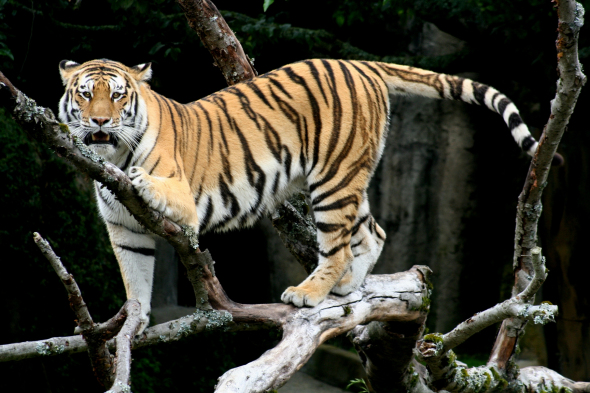
Environmental crime is a serious international problem with a detrimental impact on the global economy and security. Criminals violate national and international laws through increasingly sophisticated techniques and highly organised networks. Their activities directly affect human health, and threaten the environment and global biodiversity.
“Our efforts to fight tiger crime must not just result in seizures - they must result in prosecutions, convictions and strong penalties to stop the flow of contraband,” said Mr. John E. Scanlon, CITES Secretary-General. “If we get the enforcement system right for the tiger, we will help save countless other species together with their ecosystems.”
Tiger conservation experts presented an up-to-date situation analysis of wild tiger conservation threats, particularly worldwide and Asian trans-national organized crime links to wildlife crimes, including the trade in tigers and tiger parts.
“Wildlife and other environmental criminals too often operate in remote areas with impunity, evading detection, and circumventing full prosecution under the law,” said Mr. Keshav Varma, Program Director, World Bank Global Tiger Initiative. “The World Bank and Global Tiger Initiative fully support the resolve of the police and customs officials from tiger range countries to collaborate on intelligence. We applaud efforts to intensify pressure on the organizers of criminal networks and corrupt officials who shield them.”
Working with environmental crime experts, participating tiger-range country police and customs senior officials agreed on cross-border action points, opportunities and cooperation strategies, after discussing national priorities, challenges, and reviewing best practices.
“This important seminar has highlighted the environmental crime challenges facing senior law enforcement officers and the need for enhanced international cooperation.” said Mr. Jean-Michel Louboutin, INTERPOL Executive Director of Police Services. “Criminals cannot prosper from abusing our shared natural heritage.”
Tiger Seminar attendees discussed the need to develop a coordinated response to combat tiger crime.
“We need to work collectively through our respective environmental programmes,” said INTERPOL’s Mr. Jean-Michel Louboutin. “In this context, the INTERPOL Global Complex for Innovation in Singapore will from 2014 provide a key platform to fight environmental crimes in the 21st century.”
The Seminar also recognised INTERPOL’s Project Predator, which aims to develop the effectiveness of law enforcement agencies and form National Environmental Security Task Forces.
“If we lose an emblematic species like the Tiger, mankind will be acknowledging that it is prepared to lose any animal on the planet. This must not be allowed to happen.” said Mr. Yury Fedotov, Executive Director of UNODC. “By our actions, we must show that we have the capacity, the ability and the commitment to protect other species living on this planet.”
Compelled by the need to urgently respond to the burgeoning threat of environmental crime, five inter-governmental organisations formed in 2010 the International Consortium to Combat Wildlife Crime or ICCWC (read I-Quick). These organisations are: the Secretariat of the Convention on International Trade in Endangered Species of Wild Fauna and Flora (CITES), INTERPOL, the United Nations Office on Drugs and Crime (UNODC), the World Bank and the World Customs Organisation (WCO). The consortium seeks to scale up wildlife law enforcement effectiveness, by intelligence-led interdiction and advanced investigative methods.
The “Heads of Police and Customs Seminar on Tiger Crime” is one of the Consortium’s first activities. It is a follow-up to the November 2010 St. Petersburg Summit on Tiger Conservation, during which Heads of Governments of 13 tiger range countries committed to increase their cooperation to eradicate poaching, smuggling, and the illegal trade in tigers and tiger parts. Addressing illegal trade is an essential part of the Global Tiger Recovery Program, a comprehensive 12-year strategy endorsed by all 13 countries to double the population of wild tigers by 2022, the next Year of the Tiger.
The Seminar also addressed Decision 15.48 made at the 15th Meeting of the Conference of the Parties to the Convention on International Trade in Endangered Species of Wild Fauna and Flora (CITES) held in Doha in 2010, which states: “The Secretariat shall seek funds to convene, as soon as possible, a seminar involving senior-level Customs and police officers from tiger range States, to brief them on the threatened status of this species, particularly the impact wildlife crime has upon it. The officials shall also be briefed by the Secretariat regarding the Global Tiger Summit, planned under the Global Tiger Initiative, so that the law enforcement community throughout tiger range States is prepared to engage in efforts to safeguard this species and respond to measures adopted at the Summit. The Secretariat shall collaborate with ICPO-INTERPOL, the United Nations Office on Drugs and Crime and the World Customs Organization in preparing the seminar.”
Cites recognises that the PAOCHING crises is more of a challenge and by hitting this hard and also WARNING the offending nations that should they NOT cease or tackle poaching then by CoP 17sanctions will be placed and that will effect over twenty three nations. Cites and the signed nations have also agreed to input more Tigers into the wild, which would boost their number up by 3,000. Should the violating nations then not ACT sanctions could be placed on all nations.
Placing sanctions would be seen as catastrophic to those that deal in animal and plant part trade, many people rely on animals and plants that brings in on the “legal market millions” in revenue on the illegal market though the entire animal part trade is bringing in an estimated $25 million a year with the illegal plant trade taking in over $12 million. Think of it like a school child being given a warning “misbehave again and all your pocket money is removed”. However in order for all nations to agree on FIRMLY on this at the next meeting then the Tiger and other big cats need highlighting more.
With regards to Tiger bine wine it has been suggested in many reports and those reports from ourselves that most Tiger bine wine is now counterfeit, or is in fact a substitute. Other wildcats are being used for such non-medicinal liquors from the Lion to the Ocelot. The same applies to the Tiger balm and Rhinoceros horn of which 80% of Rhinoceros horn is indeed fake/imitation made up of fine resins and minerals.
Rhinoceros and Elephant;
The ivory trade is the commercial, often illegal trade in the ivory tusks of the hippopotamus, walrus, narwhal, mammoth, and most commonly, Asian and African elephants.
Ivory has been traded for hundreds of years by people in such regions as Greenland, Alaska, and Siberia. The trade, in more recent times, has led to endangerment of species, resulting in restrictions and bans.
While African elephants have been hunted for several centuries, the exploitation of elephant herds on a massive scale began in the 1970s. Organized gangs of poachers used automatic weapons, profited from government corruption, and laundered tons of elephant tusks through several African countries to destinations in Eastern and Western countries.
Threatened with extinction, the elephant is theoretically protected from international trade by their listing on Appendix I of the Convention on International Trade in Endangered Species of Wild Fauna and Flora (CITES) since 1989. The enforcement of this ban, the level of compliance adhered to by CITES Parties, the response of non-CITES members, as well as the policy question as to how trade “interventions” best serve the environmental objective of species preservation, are all key concerns of this dispute.
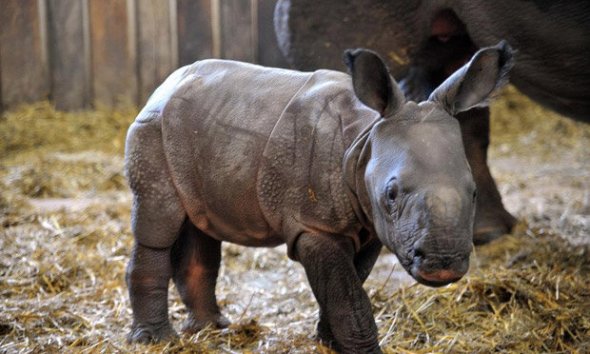
Both Asian (Elephant maximus) and African (Loxodonta africana) elephants are listed on Appendix I of CITES The Asian Elephant is now heavily endangered. Male Asian elephants have small tusks and Asian females are tuskless.
Remaining herds are located in small numbers in Nepal, India, Sri Lanka, Thailand and Sumatra and are now populated for 2012-13 at 22,000. The Asian species once was found throughout Southern Asia, was severely over-hunted. Although ivory trade has experienced sustained growth since the 1940s, the huge increase that occurred during the 1970s was the result of automatic weapons availability and widespread government corruption in many exporting countries which decimated elephant populations across Africa.
In the 1960s, raw ivory prices remained between $3 and $10 per pound. In 1975, the price reached $50 because ivory was perceived as a valuable hedge against rising inflation. By 1987, the price was $125 per pound. The relative price inelasticity of ivory also fuelled demand.
New manufacturing techniques which enabled the mass production of ivory carvings along with rising demand in East Asia led to increased elephant kills.
Hong Kong was the primary consumer of raw ivory from 1979 to 1987 and probably remains important today. Japan was the second largest consumer in this time (whose market share dropped markedly during the period), followed by Taiwan (whose share rose). For both Hong Kong and Taiwan, there is significant trans-shipment of product to China. In 1979 the EC began was a major consumer, but by 1987 its share dropped to 4 per cent. At the same time, the United States market share rose from 1 to 6 per cent
Cites quoted at CoP 15 the following;
“There has been increasing willingness within the Parties to allow for trade in products from well-managed populations. For instance, sales of the South African white rhino have generated revenues that helped pay for protection”. “Listing the species on Appendix I increased the price of rhino horn (which fuelled more poaching), but the species survived wherever there was adequate on-the-ground protection. Thus field protection may be the primary mechanism that saved the population, but it is likely that field protection would not have been increased without CITES protection”.
Trade in both Ivory and Rhinoceros horn is banned so there is not much now that Cites can do other than now order an ultimatum to the main twenty three nations that should the poaching not be ceased by the removal of ivory and tackling poachers, couriers, purchasers, kingpins to drug barons then Cites will as explained above impose immediate sanctions which would severely impact on the economy hard off the violating nations. However could placing sanction’s then increase poaching more?
This is the main worry that Cites has hence why they are cautions with regards to listing other Elephant and Rhinoceros species. So these offending nations are being given the chance, with the help of increased law enforcement, M.I.S.T and environmental policing agencies and “HELP of the Google to now remove all banned animal parts thus hitting demand harder and pushing the criminals into the streets which International Animal Rescue Foundation © required to now combat crime and cease all trade in three years. SHOULD it fail then sanctions will be implemented.
The conference has identified 23 countries including China, Nigeria and the Democratic Republic of Congo that are key to the supply and consumption of ivory.
A committee of the conference will outlined the actions that each of these countries must take to stem the trade. If these steps are not taken by the summer of 2014, sanctions could be applied.
It depends though on how much progress there is, but if there is absolutely no intent to follow up on those actions, sanctions are a very real possibility,” Targets for countries like Nigeria were achievable.
If you see ivory being sold at the airport terminals, all they need to do is shut it down. These are do-able actions, they are not ones that would require a great deal of new resources.
Governments were no longer seeing these species issues as being about biodiversity - they were seen as threats to national security. The criminals who are now poaching elephants and smuggling tiger parts are the same who are funding terrorism and funding militias.
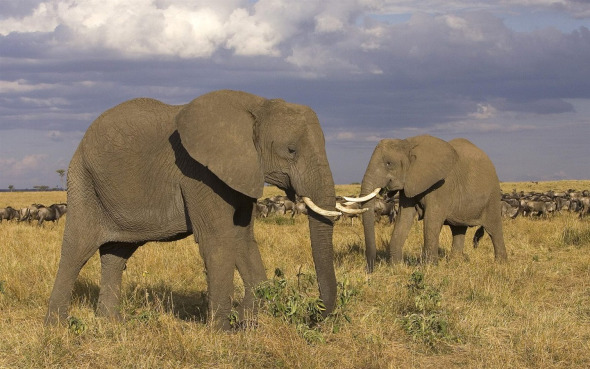
Hong Kong is already at the front line with colossal seizures from 2011-2013 http://www.scmp.com/news/hong-kong/article/1190036/hand-organised-crime-ivory-trade
Tourists are being urged now to STOP purchasing ivory from which International Animal Rescue Foundation © has seen much off and sent many papered documents to the environmental law enforcement agencies to now cease this, the press have launched now a multi-national appeal to STOP purchasing ivory this hitting trade even more http://www.asianewsnet.net/Thailand-tourists-urged-to-refrain-from-buying-ivo-43984.html
Please read following reports http://www.cites.org/eng/news/pr/2012/20120621_elephant_poaching_ivory_smuggling.php
Taiwan has stated it will also burn all ivory and ban all market trade before the next summit, Taiwan is the largest distributor and importer of ivory internationally with China and Vietnam being the second and third. http://www.bangkokpost.com/news/local/338598/thailand-in-landmark-pledge-to-end-its-ivory-trade all reports can be viewed here http://www.cites.org/eng/news/cuttings/2013.php
Rhinoceros is also under the same predicament and although there was not a mention of the trade being lifted at the Cites conference it has been seen by some “mostly Rhinoceros owners and some wildlife” agencies as unfair to allow the ivory trade to commence yet “not the Rhinoceros horn” however that is just blatantly ridiculous as on cannot de-tusk as Elephant of which all monies amassed from “sized Ivory” went into conservation protection “although that protection is to still to be seen” the sale never actually decreased poaching just made matters worse by supplying the market thus keeping the demand flow high and lucrative.
The Chinese government also then after purchasing the ivory re-sold this on for 10X the price they paid for it “that’s why poaching didn’t decrease”. The same in theory has been applied to the Rhinoceros from which the Department of Environmental Affairs quoted that the “the Rhinoceros horn debate will NOT “be lifted BUT has to spoke on as this a taboo area.
This clumsy researcher that was born in Africa that now resides in Australia printed this article on the Rhinoceros horn debate then instructed all of his friends and family, university students and more to not sign the AVVAZ petition https://www.facebook.com/photo.php?fbid=10150614157465933&set=a.10150167025165933.306936.633775932&type=1&theater then consequently contacted the DEA and other agencies to pressure the South African government on legalising it. Maybe he simply doesn’t understand a simple thing of what actually happened to the Elephant species. - http://www.abc.net.au/pm/content/2013/s3701680.htm
Most of the demand for rhino horn comes from China and Vietnam, where it is used to treat ailments ranging from headaches to cancer. The horn has no real curative powers, however–it is composed of keratin, the same material human fingernails are made of. Delegates to CoP16 in Bangkok, Thailand, congratulated the Department of Environmental Affairs for its initiatives to combat rhino poaching on the sidelines of the conference saying initiatives presently being undertaken in South Africa would enhance the global effort to fight all trans-boundary wildlife crimes.
The Department of Environmental Affairs then stated http://za.news.yahoo.com/south-africa-mulls-legal-rhino-horn-trade-123704593.html trade “has to spoke about of which SHE DID NOT state that the Rhinoceros trade WOULD be lifted. The DEA minster quoted;
“I must state categorically that there is no decision by South Africa on whether to apply to CITES at CoP17 to legalise the trade in rhino horn, or to permit the once-off sale of rhino horn stockpiles to fund conservation efforts, has been made.”
Edna Molewa 2013 March - Statement issued in the 8th March;
Update for Rhinoceros poaching 15th March 2013 is 158 Poached dead https://www.environment.gov.za/?q=content/stats_rhino_poaching_update
We were concerned about this statement though of which is going in favour of the hunting fraternity that see sustainable utilization as the only answer to control “species over population”. In our eyes there is no such thing as “animal species over population”. Our concepts are clear of which habitat destruction is the main number one issue that has to be tackled. The DEA minster quoted;
“South Africa’s position will be informed by, and based on, sustainable use principles with the long term conservation of species as the overall objective. Proposals that will ensure responsible utilization and conservation of the species concerned will be supported by South Africa”.
“Over 90 per cent of Africa’s white rhino and approximately 35% of Africa’s black rhino occur in South Africa. Rhino populations occur in formally proclaimed conservation areas as well as on private land, with the private sector contributing approximately 2.2 million hectares of land towards rhino conservation, with more than 4 000 rhino in private ownership. The populations occur throughout South Africa in all its provinces”.
“South Africa developed a Biodiversity Management Plan (BMP) for the Black rhino, aimed at ensuring the long-term survival in nature of the species, and is in the process of developing a BMP for white rhino. Key elements are the maintenance of existing ranges, the promotion of long term genetic viability and the establishment of new viable populations. South Africa shared information relating to the status of its rhino populations and interventions implemented and planned to secure its long term survival”.
South Africa has seen an increase in the illegal killing of its rhinoceros population, especially the white rhino population in the Kruger National Park where 425 animals have been poached for its horns in 2012.
While it is clear that rhino poaching has increased, so too has the focus and activities of the South African security forces in attempts to protect the rhino. South Africa has implemented various measures to counter the slaughtering of its rhino population, but 2012 saw the greatest number of rhinoceros killed in a single year, i.e. 668.
The side event at CITES CoP 16 was intended to show participants, attending the CoP, what South Africa has done in the fight against the illegal killing of rhino and illegal trade in rhino horn; and what additional measures are required to ensure the safety and security of our rhinoceros population.
The current annotation to the Appendix II listing of the white rhino populations of South Africa and Swaziland restricts trade to live specimens to appropriate and acceptable destinations and hunting trophies. A proposal to prohibit the export of hunting trophies until at least CoP 18 was submitted by a Party for consideration to the 16th CoP to CITES. This proposal was opposed by South Africa and Swaziland and it highlighted the need to have a discussion on the role of trade in the conservation of the species. During the side event presentations were made to elicit discussions relating to this important topic.
The Department of Environmental Affairs (DEA) is currently leading the development of the UNEP-GEF project ‘Strengthening Law Enforcement Capabilities to Combat Wildlife Crime for Conservation and Sustainable Use of Species in South Africa (target: Rhinoceros)’. The main aim of the GEF project is to improve the forensic and intelligence/information sharing capabilities of relevant groups to better control the recent upsurge in poaching of rhinoceros in South Africa’s protected area network, especially Kruger National Park. South Africa shared the information relating to the project with the CITES Parties and NGO community.
South Africa participated in the CITES and Livelihoods side event that reflected on the role international trade plays in terms of livelihoods of communities and the challenges and opportunities that it presents. The case study of the Tyhefu Traditional Council Aloe Project was presented by a community member of the project itself, Mr Mangwanandile Witness Mjoli.
Please read below the key components for your interest;
https://www.environment.gov.za/sites/default/files/docs/rhinopopulation_stateownedland.pdf
https://www.environment.gov.za/sites/default/files/docs/protection_ofrhino_species.pdf
https://www.environment.gov.za/sites/default/files/docs/unep_gef_project.pdf
One must not yet look at everything in all doom and gloom, the facts have been clearly stipulated and proven above, we must now all work as an international TEAM to combat illegal poaching, reduce demand, and protect our species of which transnational law enforcement forces are now undertaking. We must also remember that the Rhinoceros horn trade HAS NOT been lifted and the Rhinoceros is still listed as near threatened and not vulnerable.
Focusing on these key important areas thus using every piece of technology, equipment, funding, team work and more must NOW be seen as critically important for the next meeting at CoP 17 to be held in South Africa.
Thank you for reading
International Animal Rescue Foundation
Director
Co- Founders
International Delegates
Administrative Delegates
Youth Ambassadors China, Amazonia, America, Malaysia
http://www.grida.no/publications/rr/elephants/ (THE CRISIS CAN BE ADDRESSED)
There are 500,000 African Elephants left in the wild - Please download the most comprehensive and up to date research. Please watch the video above as it’s most important. There is also a 40Mb Pdf FILE that you can download. ELEPHANT range is now second to POACHING - Agriculture, supplying markets outside of Africa, land conversions from which South Africa ha now ceased all migrants from purchasing land so South Africa has known of this problem for some time. Habitual loss and human over population are KILLING the Elephants too. This now MUST be seen as MOST important that need’s tackling.. 60% decline is very worrying
RRAivory_draft7 Download Elephants in the Dust
25,000 left in the wild however hunting is declining in this with increased crime efforts to combat illegal trade and wildlife trade in vulnerable species.

